Restoration of Indigenous Plants and Construction of Sustainable Value Chains in Indigenous Communities
23.05.2025
SUBMITTING ORGANIZATION
Agency of Rural Development and Soil and Water Conservation, MOA
OTHER CONTRIBUTING ORGANIZATIONS
National Chung Hsing University
Hengchun Research Center, Taiwan Forestry Research Institute, MOA
Taiwan Landscape Environment Association (TLEA)
DATE OF SUBMISSION
2025
REGION
Asia
COUNTRY
Chinese Taipei
KEYWORDS
Ethnobotany, In-situ Restoration, Sustainable Value Chain Development
AUTHORS
Chen-Yang Lee1, Can-Tang Ke2, Chen-Fa Wu3*, Wen-Chih Lin4, Yi-Han Chang4, Vavua Papalicang5, Cheng-Hsiu Tsai2, Chien-Hung Tsai2, Chun-Hsien Lai6, Ching-Jin Kuo6, Hao-Wei Hsu6, Sylvatera Ayu Puspitasari3
* Corresponding: Chen-Fa Wu 1 Agency of Rural Development and Soil and Water Conservation (ARDSWC) 2 ARDSWC Tainan Branch 3 Department of Horticulture of National Chung Hsing University (NCHU) 4 Hengchun Research Center, Taiwan Forestry Research Institute (TFRI) 5 Gaoshi Community Development Association Mudan Township 6 Taiwan Landscape Environment Association (TLEA)
Summary Sheet
The summary sheet for this case study is available here.
Summary
Gaoshi is an indigenous Paiwan tribe rich in ecology and history. The local plant diversity is so abundant that 15 species are named based on the village, “Gaoshi,” as their discovery location. The close connection between the residents and nature led to over 200 plant species being integrated into the lives of the tribe members. However, as time went by, the tribe gradually began to forget the use of traditional plants. Environmental destruction also caused the disappearance of several Gaoshi-named plants from their native habitats. In response, the Tainan branch of the Rural Development and Soil and Water Conservation Agency has worked with the Gaoshi tribe and other organizations to implement a series of strategic measures. One of the main initiatives is called ‘Gaoshi Returns to Hometown,’ which aims to return Gaoshi-named plants to the tribe and carry out in-situ restoration. Promotion homegarden encourage residents to plant traditional plants, awakening and passing down the knowledge of plant usage. Additionally, the work strengthens ancestral wisdom to develop an under-forest economy based on traditional knowledge and creates ecological tourism programs with local characteristics. Through the participation of the tribe members and knowledge sharing, these measures have successfully protected the biodiversity of the Gaoshi tribe. They have also established a sustainable value chain, ensuring the revival and preservation of the Gaoshi tribe’s traditional plant culture.
Geographical Information
1. Socioeconomic and environmental characteristics of the area
1.1 The Environmental Characteristics of Gaoshi Village
Gaoshi Village, formerly known as Kaoshifo, is a Paiwan indigenous tribe located at the southern tip of Taiwan’s Hengchun Peninsula in Mudan Township, Pingtung County. The village is surrounded by mountains on all sides and offers a distant view of the Pacific Ocean to the east. Gaoshi Village, with an area of approximately 2,478 hectares, is shaped by the mountain range that extends from the southernmost section of the Central Mountain Range, resulting in a continuous, rugged landscape. The region’s average slope is around 20 degrees, with the steepest slopes reaching 50 degrees.
The topography is characterized by valleys higher in the northwest and gradually lower towards the southeast, with a predominant south-facing aspect. The elevation of Gaoshih Village ranges from 25 to 552 meters, with an average altitude of 286 m. Due to its location, the area enjoys abundant sunlight, with an annual average total solar radiation of approximately 5,555 MJ/m². Moreover, the relatively long rainy season makes this area rich in river flows. From north to south, these include the Gangzai River, Jhonggang River, Buyouluan River, Bala River, and Gangkou River, which are the upper.
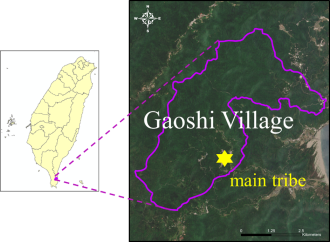


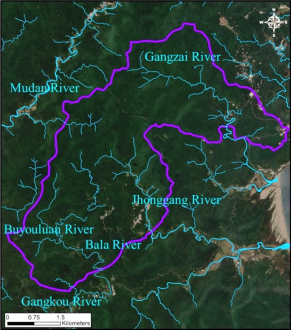
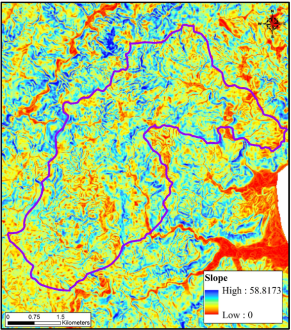
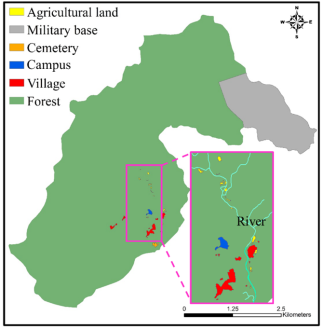
Note: The above materials were produced by our team.
Geologically, Gaoshi Village is part of the Mutan Formation, which dates back to the Late Miocene. This formation is dominated by thin-bedded shale and sandstone sedimentary rocks. The soil of Pingtung County at the southern tip of the Hengchun Peninsula is mainly laterite. This condition causes the core community of Gaoshi Village to be characterized by widespread laterite soil, which limits agricultural development. As a result, only dry crops such as red quinoa can be grown (Gaoshi Village Rural Regeneration Program, 2011).
1.2 Climate Characteristics of Gaoshi Village
Gaoshi Village is located south of the Tropic of Cancer, in a low-elevation foothill area, and falls within the tropical monsoon rainforest climate zone. Between 2021 and 2023, the village’s average annual temperature was around 22.0°C, with the highest monthly average temperature reaching 25.9°C in July and the lowest dropping to 16.8°C in January. Precipitation is most abundant during the summer (May to July) and fall (August to October). During the summer, rainfall is mainly influenced by afternoon thunderstorms and typhoons, while other months also experience frequent rainfall, resulting in a consistently humid climate with very short dry periods. With a long rainy season and dense vegetation, relative humidity remains high throughout the year with slight variation, with summers tending to be more humid than winters. Monthly average relative humidity typically ranges from 85% to 96%.


In Taiwan’s winter season, approximately from October to April, the northeast monsoon prevails. As it crosses the lower section of the Central Mountain Range, strong katabatic winds (locally known as “Luo Shan Feng”) rush down toward the Hengchun Peninsula. During this period, the average wind speed can reach 11.1 m/s (Hu, 2001). Although Gaoshi Village is located on the Hengchun Peninsula, its elevation and position on the eastern side of Taiwan result in a milder effect from the northeast monsoon compared to the flatlands of the peninsula. However, the monsoon still impacts the local forest vegetation. On the windward slopes, plants are exposed to strong winds, which cause them to grow relatively shorter and more densely. In contrast, less affected by the monsoon, the valley areas allow taller trees to thrive, with lower plant density overall (Huang et al., 2006).
1.3 Natural Resources of Gaoshi Village
The humid and warm low-elevation environment of Gaoshi Village has nurtured a rich array of biological resources. As a result, the government has designated approximately 68.8% of the Gaoshi Village area as a focus zone within the ecological network. This initiative aims to preserve the rich biodiversity of the forests and streams, improve and maintain the unique ecological environment of the Hengchun Peninsula’s independent streams, and promote community collaboration to protect the region’s Satoyama landscape.

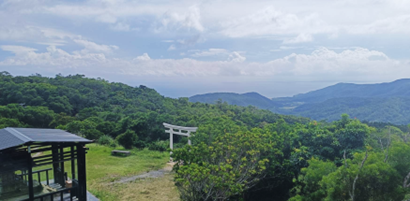
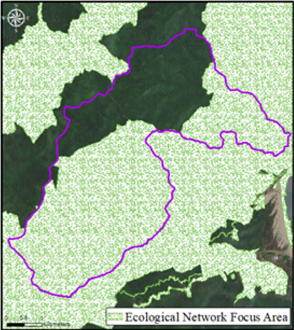
Note: The above materials were filmed and produced by our team.
According to open ecological survey data from the Taiwan Biodiversity Information Alliance and Taiwan Biodiversity Network, as well as biological resources previously identified by the village elders and provided by the Gaoshi Community development associations, all three sources indicate that Gaoshi Village is exceptionally rich in both animal and plant resources. Additionally, the village hosts a number of Taiwan’s endemic species and conservation-dependent animals and is also an important area for species listed in the Red Data Book of Species in Taiwan. Detailed information on these species can be found below (Appendix I).
(1)Plant resources:
A total of 570 species from 131 plant families are included, including 88 endemic species (ES), such as Syzygium kusukusense, Ardisia kusukusensis, and Ormosia hengchuniana. Also, 25 species, including Lindsaea lucida, Symplocos sasakii, and Neolitsea hiiranensis, are listed as Vulnerable (VU) threatened plants.

(2)Animal resources:
A. Mammals:There are 22 species from 15 families, including 5 endemic species such as Macaca cyclopis and Capricornis swinhoei. Also, 3 protected wildlife (PW) species, such as Herpestes urva formosanus and Manis pentadactyla pentadactyla, are present.

B. Birds:There are 44 species from 26 families, including 11 species that are endemic to Taiwan, such as Lophura swinhoii, Myophonus insularis, and Pomatorhinus musicus. Additionally, there are 15 species of conservation-dependent birds, such as Ictinaetus malaiensis and Heterophasia auricularis. Among them, Milvus migrans and Pycnonotus taivanus are listed as vulnerable species.

C. Amphibians and Reptiles:There are 35 species from 14 families, including 7 endemic species such as Bufo bankorensis, Zhangixalus moltrechti, and Takydromus formosanus. Additionally, there are three conservation-dependent species: Takydromus sauteri, Deinagkistrodon acutus, and Cuora flavomarginata. Among them, Cuora flavomarginata has been listed as a vulnerable species due to severe poaching.

D. Aquatic animal:The aquatic ecosystem includes species such as Anguilla marmorata, Rhinogobius henchuenensis, Stiphodon percnopterygionus, Macrobrachium lar, Platyeriocheir formosa, Candidiopotamon rathbuni, Caridina typus, and Geothelphusa albogilva. Among these, Rhinogobius henchuenensis is endemic to Taiwan and is listed as an endangered species.
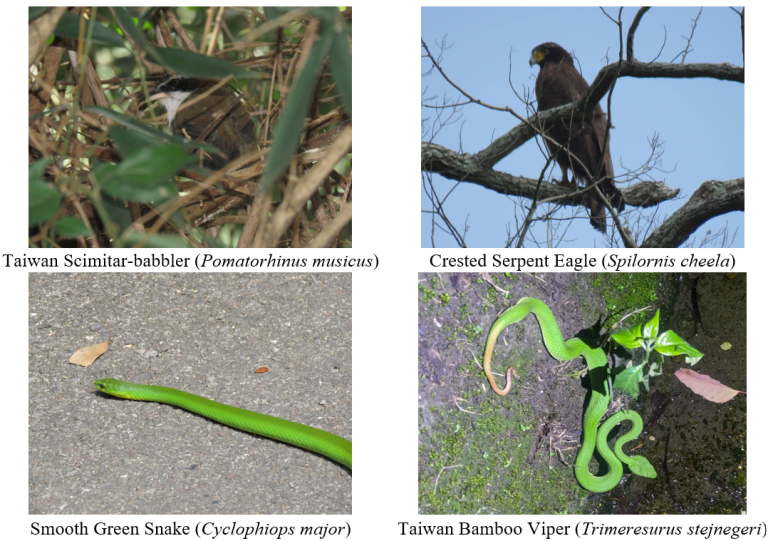
Note: The above photos were taken by our team.
1.4 Culture of Gaoshi Tribe
The Austronesian-speaking peoples are widely distributed, from Madagascar in the east to Easter Island in the west, New Zealand in the south, and Taiwan in the north. The sixteen indigenous groups of Taiwan belong to the Austronesian language family, each with its unique language, traditions, belief systems, and social structures. These groups are scattered across various regions of Taiwan, with the indigenous groups active in southern Taiwan primarily being the Rukai and Paiwan tribes.
Gaoshi is an ancient tribe of the southern Paiwan people, specifically the Paliljaliljaw group. According to legend, the tribe’s ancestors migrated to the Hengchun Peninsula region around 500 to 600 years ago. Throughout history, they have moved their settlement seven times, ultimately settling in their present location nearly 80 years ago. The Paiwan name for Gaoshi Tribe is “Kuskus.” One interpretation is that the name originates from the sound of cut grass. Another explanation is that “Kuskus” refers to using a small knife to scrape the meat off bones. According to this version, the name reflects where the ancestors initially settled, characterized by high terrain and strong winds. The wind, sharp as a small knife, would strip the flowers, grass, and trees bare, and it was from this natural occurrence that the tribe derived its name. (Chang, 2022). In addition, the area around the Gaoshi tribe is surrounded by wild peonies. When the pale purple flowers bloom, they resemble jewels, earning Gaoshi the beautiful nickname “Southern Paiwan Ruby.” Due to its relatively open geographic environment, the Gaoshi Tribe has had easy access to interactions with neighbouring groups such as the Amis, Hakka, and Hoklo. It caused the tribe to develop a unique cultural identity that distinguishes it from other Paiwan tribes (Chang, 2022).
1.5 Population of Gaoshi Tribe
According to the population data for May 2024, Gaoshi Village has 246 households and a total population of 631, with 314 males and 317 females. Of this population, 63 are children (aged 0-14), 471 are teenagers and working-age people (aged 15-64), and 97 are elderly individuals (aged 65 and above). The elderly makeup about 15% of the population, indicating that the Gaoshi tribe has entered an ageing society and is gradually moving toward a super-aged society.
1.6 The Life of the Indigenous People of Gaoshi Tribe
The life of the Gaoshi Tribe is closely tied to seasonal rituals and ceremonies. The tribe’s interactions with the natural environment have shaped unique beliefs and rituals in response to the changing seasons. Along with time, these practices have evolved into distinctive cultural elements specific to the tribe, including their cuisine, clothing, building materials, and festivals. For example, in the past, the indigenous people of Gaoshi used locally sourced slate to build their homes. The slate house ruins scattered across the Mudan Township region may appear desolate, but they silently tell the story of the ancestors’ way of life (Mudan Township Office, 2022). Some tribe members also chose thatch as a building material for their homes. These materials have in common that they are sourced locally, reflecting the close relationship between the indigenous people and their natural environment.
Like most of Taiwan’s indigenous tribes, the Gaoshi Tribe follows a traditional belief system based on “animism” and “ancestor worship.” Central to these beliefs is the concept of tsemas, which encompasses various supernatural beings and spirits, such as mountain gods, river gods, ancestor deities, ancestral spirits, and ghosts (Council of Indigenous Peoples, 2023). Therefore, the tribe holds seasonal ceremonies such as the “icacevung” ceremony (held to welcome the ancestral spirits) and the Millet festival to seek the protection of their ancestors and ensure a bountiful harvest. These rituals reflect the Gaoshi people’s way of life, deeply rooted in living in harmony with nature. However, one-third of the tribe members have converted to Christianity, and the traditional belief in ancestral spirits is gradually declining (Hsu et al., 2012). As for the Japanese colonial period, the Japanese built the Gaoshi Shrine in the Gaoshi tribe, dedicated to the sun goddess Amaterasu. After World War II, the shrine fell into disrepair, but in recent years, it has been restored, and a white torii gate was erected. Today, the site is revered as a memorial to the tribal members who lost their lives during World War II.
2. Description of human-nature interactions in the area
2.1 The Production of the Gaoshi Indigenous People
During the Japanese colonial period, the Gaoshi tribe was one of the first tribes to develop rice farming. However, most lands used for rice cultivation have been abandoned today. The primary reasons for this shift include the relocation of the tribe and the government’s promotion of fallowing and crop-type transfer policies, which have had a significant impact on the local rice industry (Gaoshi Village Rural Regeneration Program, 2011). The cultivation of log-grown shiitake mushrooms was once a thriving industry in the Gaoshi tribe. About 50 years ago, nearly 80% of the tribe’s members were involved in growing log-grown shiitake mushrooms. However, excessive deforestation led to a shortage of suitable logs for cultivation, and the influx of low-priced imported mushrooms impacted the industry. As a result, the industry has declined drastically, and today, only nine households continue to grow shiitake mushrooms using logs.
In recent years, the Gaoshi people have transformed areas near their homes into home gardens to cultivate vegetables and other crops. Common crops include betel nut, nest fern, and papaya, which are favoured by the tribe. Additionally, taro, millet, and red quinoa, traditional staple foods of the Paiwan people, are also grown. These traditional crops are cultivated using environmentally friendly methods, primarily for self-sufficiency rather than export. Tribe members have introduced spring water to create ponds for aquaculture, raising tilapia, giant freshwater prawns, and field snails. They also raise chickens in the area. Through these efforts, the Gaoshi tribe continues to preserve their agricultural heritage while adapting to modern practices for sustainable living.
2.2 The Hunting Culture of the Gaoshi Tribe
The residents of the Gaoshi tribe view themselves as a part of nature. Therefore, their hunting culture is based on the concept of living in harmony with the environment. Each hunter is assigned a specific hunting area and is prohibited from hunting in another’s territory. They also refrain from wiping out any species due to personal preference, aiming to maintain animal populations and allow for their reproduction. Before hunting, the hunters place their tools and traps in the hunter’s house for the shaman to cleanse, ensuring a smooth hunt. After the hunt, they offer prayers for the animals they have caught, expressing respect and gratitude for the life in nature. Nature serves as a refrigerator for the Gaoshi tribe, where the residents gather vegetables and hunt animals according to their traditional territory’s changing seasons and climate. For example, when heavy rain makes the river muddy, it is the perfect time to fish for eel and capture mitten crabs which drift downstream. During frequent rain, they can gather Nostoc commune (terrestrial blue-green algae) from the grasslands. After the rain clears in the afternoons, they can also collect snails. This harmonious relationship with nature allows the Gaoshi tribe to live sustainably, relying on the land’s resources while respecting its natural cycles.
2.3 The Plant Utilization Culture of Gaoshi Tribe
Through years of experience, the Gaoshi people have developed a rich ethnobotany, incorporating more than 200 plant species into their daily lives. It shows their profound knowledge and extraordinary plant utilisation skills for various purposes. Based on the surveys conducted by Cheng et al. (2005) and Lu et al. (2011), the following section will introduce the applications of plants in five major areas: housing, clothing, food and diet, ritual, and medicine.
(1) Housing
Traditional Paiwan architecture can be categorized into three functional types: residential houses, workshops, and hunting lodges. Residential houses are built using materials selected for long-term durability. Pillars are typically made from moisture-resistant and decay-resistant tree species, such as Taiwan zelkova (Zelkova serrata), hengchun eugenia (Syzygium kusukusense), pop-gun seed (Bridelia tomentosa), and prickly bridelia (Bridelia balansae). Beams and rafters utilize tree species known for their seismic resistance and weight-bearing capacity, including large-leaved nanmu (Machilus kusanoi), camphor tree (Cinnamomum camphora), and Dysoxylum hongkongense. Binding ropes are made from margaret rotang palm (Calamus formosanus) and bush cane (Flagellaria indica). The roof is typically constructed from white cogongrass (Imperata cylindrica) and Miscanthus sinensis. For a secondary option, use sword grass (Miscanthus floridulus) with its larger pores. For simpler structures such as workshops and hunting lodges, the materials used are typically smaller-diameter trees, including Wendlandia uvariifolia, weeping fig (Ficus benjamina), India charcoal trema (Trema orientale), Formosan alder (Alnus formosana), flying spider monkey tree fern (Alsophila lepifera), Taiwan mulberry (Morus australis), and thorny bamboo (Bambusa stenostachya).
Simpler structures such as workshops and hunting lodges are generally constructed using smaller-diameter trees. Commonly used species include Wendlandia uvariifolia, weeping fig (Ficus benjamina), India charcoal trema (Trema orientalis), Formosan alder (Alnus formosana), flying spider monkey tree fern (Alsophila lepifera), Taiwan mulberry (Morus australis), and thorny bamboo (Bambusa stenostachya). The roofing material is often made from sword grass and Taiwan giant reed (Arundo formosana).
(2) Clothing
In the past, the Paiwan people used paper mulberry (Broussonetia papyrifera) bark to make bark cloth as one of their primary materials for clothing. Additionally, they also used ramie fiber to weave fabric. The traditional clothing of the Gaoshi people was influenced by the Hakka, and it is primarily characterized by the use of blue, red, and white colors. Blue dye was made from the leaves of the common conehead (Strobilanthes cusia). Red dye was extracted from the underground rhizomes of shoulang yam (Dioscorea cirrhosa). Black dye was obtained from the stems of the oldham scolopia (Scolopia oldhamii) or the leaves of subcostate crape myrtle (Lagerstroemia subcostata). Purple-black dye came from the fruits of ceylon spinach (Basella alba).
(3) Food and Diet
Before the industrial development era, the Paiwan people utilized their knowledge and common sense to optimally use the plant resources around them to meet their daily needs. Table 3 is an example of the traditional food and dietary plants of the Gaoshi tribe.
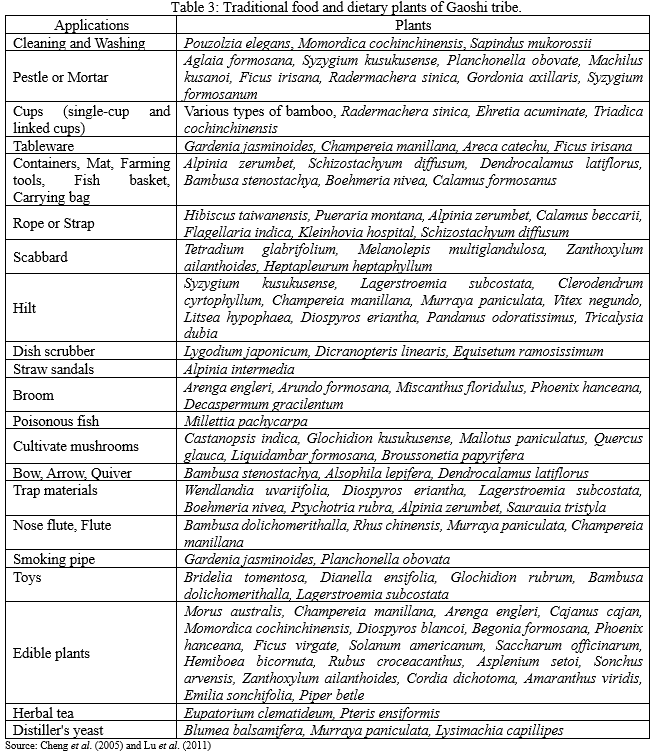
(4) Rituals
Plants are closely related to the rituals of the Gaoshi tribe. For example, in the icacevung ceremony, shamans use the leaves of the Formosan plant (Callicarpa formosana) as containers for offerings. After attending a funeral, people tuck several leaves of the three-leafed acanthopanax (Eleutherococcus trifoliatus) into their heads and bodies to prevent evil spirits from attaching themselves. In addition, they pass through an archway made of sword grass (Miscanthus floridulus) to ensure that no evil spirits follow them home. In addition, the seeds of the soap plant (Sapindus mukorossi), which resemble human pupils, are also used by shamans as sacred marbles in divination practices.
(5) Medical
Traditionally, the Gaoshi people have used various plants to treat internal diseases and external wounds. Young leaves of chinaroot greenbrier (Smilax china) are used to relieve inflammation of the tongue; harlequin glorybower (Clerodendrum trichotomum) is used to treat headaches and rheumatism; leaves of formosanum elderberry (Sambucus chinensis) are used to treat headaches and sprains; young leaves of subcostate crape myrtle (Lagerstroemia subcostata) are crushed to reduce inflammation and treat wounds; roots of white cogongrass (Imperata cylindrica) are boiled to reduce fever; branches and leaves of rotten securinega (Flueggea suffruticosa) are boiled to treat measles; soft spikemoss (Selaginella delicatula) is used to stop bleeding and treat wounds; Blumea balsamifera boiled in hot water is used to relieve body aches; and boiled leaves of coastal betel (Vitex rotundifolia) are used to treat stomachaches. In cases where the cause of the illness is unknown, spirit mediums will use plants such as betel nut, sword grass (Miscanthus floridulus), harlequin glorybower, and pandanus odoratissimus to perform divination and ritual healing.
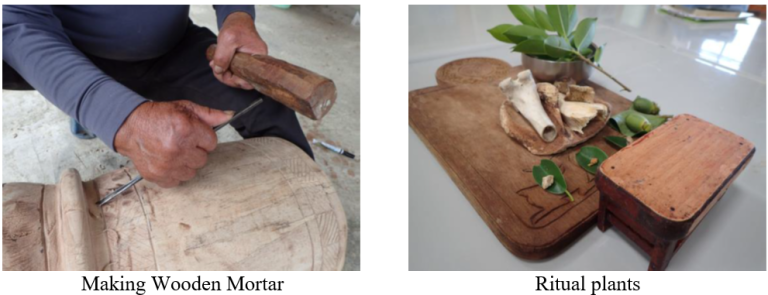
Contents
1. Rationale
To understand the progress of the Gaoshi Tribe in implementing the Satoyama Initiative, Tainan Branch, Agency of Rural Development and Soil and Water Conservation (ARDSWC) assisted the Gaoshi community in conducting a community resilience assessment. The assessment focused on five indicators: landscape/seascape diversity and ecosystem protection, biodiversity, knowledge and innovation, governance and social equity, and livelihood and well-being. The results show that the Gaoshi tribe received lower scores in the indicators of landscape/seascape biodiversity and ecosystem protection and biodiversity. However, in the past, the Gaoshi Tribe had a diverse landscape that supported various life forms. In particular, 15 plant species have been identified in the Gaoshi area and named after their old name, “Kaohifo.”
1.1 Literature Review of Gaoshi-Named Plants
Gaoshi has a rich diversity of biological resources. Due to its unique climate zone, which is different from most areas in Taiwan, it has developed a unique plant community. As a result, botanist Tashiro Yasusada chose Gaoshi as his base for plant surveys on the Hengchun Peninsula during the Japanese colonial period in Taiwan. In 1902, Tashiro established the Koushun Tropical Botanical Laboratory and the Fourth Mother Tree Garden in Gaoshi Village, making Gaoshi an important location in the history of botanical research in Taiwan.
(1) Background of Plant Research in Gaoshi
In 1902, the Japanese government appointed Tashiro Yasusada to establish the Fourth Mother Tree Orchard in Gaoshi. The garden aimed to collect and introduce various economically valuable tropical and subtropical plants for experimental cultivation. Located in a mountainous region, Gaoshi served as a center for cultivating mountain plants and conifers, with various plants such as bananas, coffee, teak, Taiwan cypress, luanta cypress, and Buddhist pine being planted in the area (Yang et al., 2024). The establishment of the Fourth Mother Tree Orchard marked the beginning of botanical researchers establishing field stations in Gaoshi to collect and research plants. Among the prominent Japanese scholars were B. Hayata, S. Sasaki, T. Soma, Y. Kudo, S. Suzuki, and N. Fukuyama.
Currently, the Koushun Tropical Botanical Laboratory has been renamed the Hengchun Research Center, Taiwan Forestry Research Institute (TFRI), which is ongoing to continue research on collecting and conserving tropical plants in Taiwan. In addition, the Fourth Mother Tree Orchard has been renamed the Kaoshifo Experimental Forest, equipped with permanent plots to monitor and study long-term changes in the forest ecosystem.
(2) Records of Gaoshi-named plants
In 1912, B. Hayata and S. Sasaki published 14 new species of vascular plants, which attracted the academic community’s attention to the Gaoshi region. In addition to these 14 species, other species were also named Gaoshi after the restoration of Taiwan. In 1999, S.Y. Lu, a prominent Taiwanese botanist, published a new species, Boehmeria densiflora form “Noble Buddha,” which added to the list of plants associated with Gaoshi.
(3) Definition of Gaoshi-named plants
During the Japanese colonial period, Gaoshi was referred to as “Kaoshifo Tribe”, while the local name in the Paiwan language was “Kus kus”. In the academic field, the pronunciation “Kusukusu” was used as a root for taxonomic names. Therefore, plant species that include terms such as kusukusensis (m., f.) or kusukusense (n.) in their scientific names are defined as “Gaoshi-named plants.” In addition to these, plant species that do not have “kusukusu” in their scientific names but are commonly known by the Chinese vernacular name “Kaoshifo (高士佛)” are also included within the definition of Gaoshi-named plants.
(4) Types of Gaoshi-named plants
According to a survey conducted by the Hengchun Research Center TFRI, there are currently 15 plant species named after Gaoshi. Based on the relationship to the naming of Gaoshi, these plants can be categorized into three main groups:
A. Species that still use the specific epithet kusukusu:
- Syzygium kusukusense (Hayata) Mori
- Ardisia kusukuensis Hayata
- Glochidion kusukusense Hayata
- Oberonia kusukusensis Hayata
- Tectaria kusukusensis (Hayata) Lell.
B. Species originally published with the specific epithet ‘kusukusu’ were later corrected and reclassified under different species (the current scientific name is provided in parentheses)
- Chisocheton kusukusense Hayata (Dysoxylum hongkongense (Tutcher) Merr.)
- Bulbophyllum kusukusensis Hayata (Bulbophyllum affine )
- Diploprora kusukusense Hayata (Diploprora championii (Lindl. ex Benth.) Hook. f.)
- Galera kusukusensis Hayata (Epipogium roseum (D. Don) Lindl.)
- Sarcochilus kusukusensis Hayata (Thrixspermum merguense (Hook. f.) Kuntze)
- Polypodium kusukusense Hayata (Leptochilus wrightii (Hook.) X.C. Zhang)
- Lindsaea kusukusensis Hayata (Lindsaea lucida Blume)
C. Species with specific epithets other than kusukusu, but whose common Chinese names are derived from “Kaoshifo (高士佛)”:
- 高士佛澤蘭 (Eupatorium clematideum gracillimum)
- 高士佛羊耳蒜 (Liparis somai Hayata)
- 高士佛苧麻 (Boehmeria densiflora ”Noble Buddha”)
(5) Introduction to Gaoshi-named plants
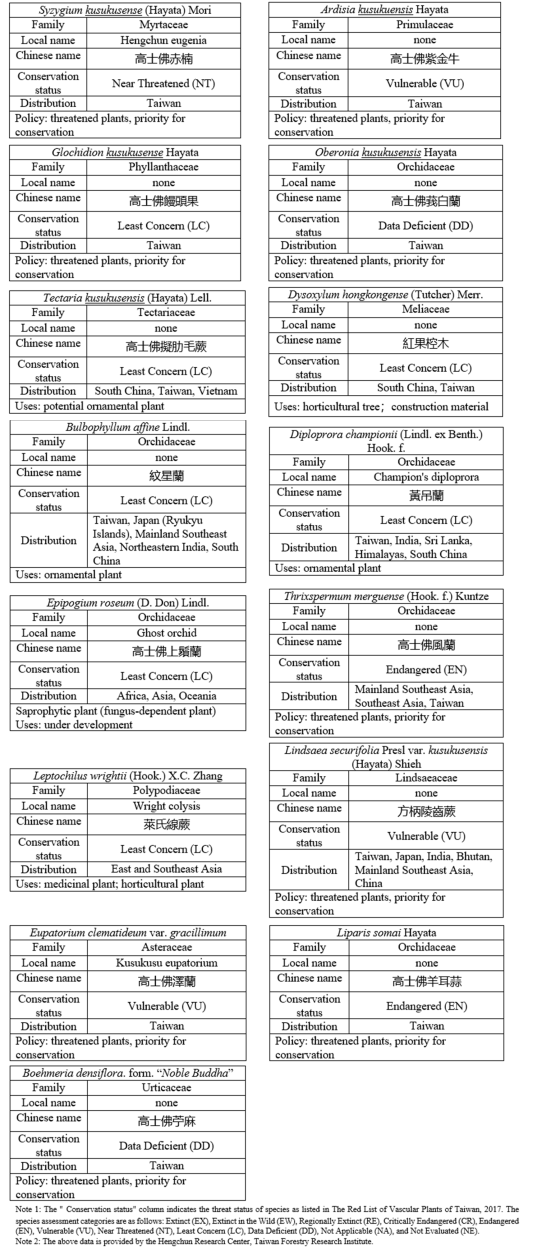
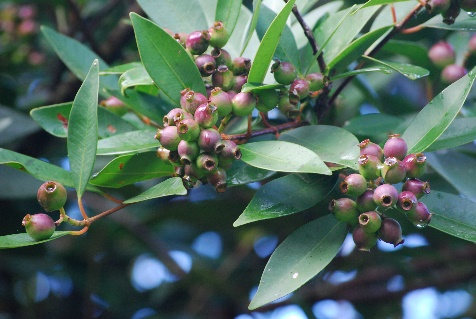

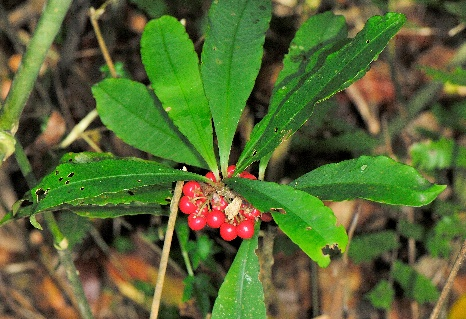
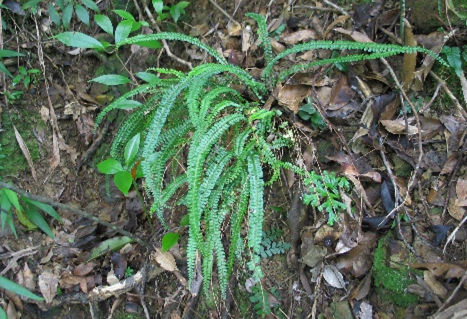
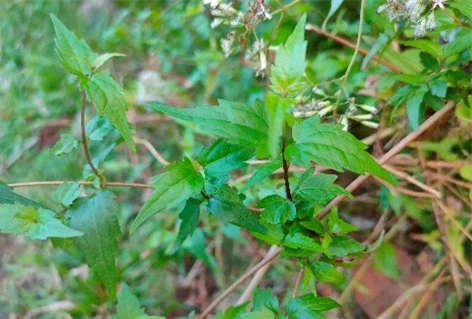
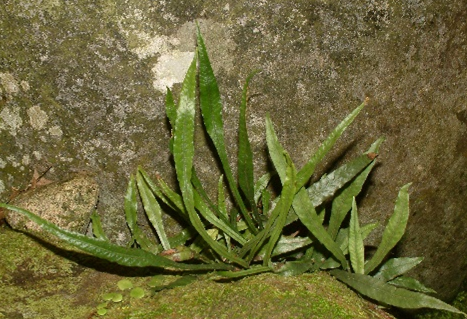
Note 1: The above photo is provided by researcher Yi-Han Chang.
1.2 The Disappearance of Gaoshi-Named Plants
The Gaoshi area was once a hub for plant research during the Japanese colonial era due to its rich plant resources. However, with economic development, many forests were cleared for agricultural cultivation or residential construction, leading to the destruction of the original landscape. Additionally, some ornamental plants faced significant collection pressures, and a combination of factors has caused certain native species to become increasingly scarce, with some even disappearing entirely from the region. According to a study by Yang et al. (2024), among the 15 plant species named after Kaoshifo, five species—Oberonia kusukusensis, Liparis somai, Thrixspermum merguense, Glochidion kusukusense, and Boehmeria densiflora form. ”Noble Buddha”—have not been observed in the Gaoshi area for many years. Furthermore, the populations of Bulbophyllum affine, Diploprora championii, and Epipogium roseum have almost disappeared from the region, posing a serious threat to the continuation of the local indigenous community’s plant-based cultural knowledge and practices.
Due to its rich plant resources, the Gaoshi area was once a center for plant research during the Japanese colonial era. However, with economic development, many forests were cleared for agricultural or housing development, destroying the original landscape. In addition, some ornamental plants are under great pressure from excessive collection practices. The combination of these factors has caused some native species to become increasingly rare, with some even disappearing from the area. According to a study by Yang et al. (2024), among the 15 plant species named by Kaoshifo, five species—Oberonia kusukusensis, Liparis somai, Thrixspermum merguense, Glochidion kusukusense, and Boehmeria densiflora form. “Noble Buddha” group have long been absent from the Gaoshi area. In addition, Bulbophyllum affine, Diploprora championii, and Epipogium roseum populations are nearly extinct in the area. This situation seriously threatens the sustainability of the local indigenous people’s plant-based cultural knowledge and practices.
(1) Environmental damage
Environmental development and habitat degradation are among the main causes of the loss of plants named after Gaoshi. For example, except for Epipogium roseum, all five species of orchids named after Gaoshi are epiphytes, growing primarily on tree trunks. Because their roots are exposed to the air, these epiphytic orchids have relatively strict requirements for their microhabitats. Even the slightest disturbance can change the environmental factors of their habitats, potentially preventing them from continuing to survive.
For example, Liparis somai prefers moist, shady, and cool environments and is mainly found on large trees along mountain streams in southeastern Taiwan. However, along the Jhonggang River near the Gaoshi settlement, large trees were cut down during the Japanese colonial era for rice cultivation. Significant changes in habitat and microclimate in this area are likely key factors contributing to the loss of Liparis somai from the Gaoshi area. Significant changes in habitat and microclimate in this area are likely key factors contributing to the loss of Liparis somai from the Gaoshi area.
(2) Excessive logging and collection
Excessive logging is also one of the reasons for the disappearance of plants named after Gaoshi. Syzygium kusukusense, known for its high-quality wood, has been logged on a large scale and was one of the first species to disappear from the Gaoshi region. Similarly, Bulbophyllum affine, Diploprora championii, Thrixspermum merguense, and Oberonia kusukusensis, all valued for their ornamental qualities, have been under intense collection pressure for many years. In particular, the wild populations of the latter two species have been gradually decreasing. These plants are now more often seen in flower markets than in their natural habitat.
The wild population of Eupatorium clematideum var. gracillimum also faces the problem of excessive collection. Although this plant is not particularly attractive as an ornamental plant, it is an important nectar source for various butterfly species. This has prompted people to collect it from the wild and plant it at home to attract butterflies. In the past, the Gaoshi people planned to plant Eupatorium clematideum var. gracillimum along the roadside to create a butterfly corridor. However, irresponsible people soon completely harvested the plants. Similarly, Taiwan fig trees (Ficus formosana), originally planted on both sides of the old road, were also completely dug up for their medicinal properties. This highlights the rampant illegal plant collection in the area.
1.3 Youth Outmigration and the Disappearance of Traditional Culture
As time passed, traditional materials such as ramie fiber fabric and plant-based dyes have been replaced by synthetic fibers, while traditional houses like thatched huts and mud-brick homes have given way to modern steel and concrete buildings. These lifestyle changes have led to the gradual disappearance of Gaoshi’s indigenous plants from daily life. The younger generation, also drawn to urban areas for work due to the community’s remote location and lack of economic development, has contributed to the gradual decline of the village. Typhoon Morakot in 2009 had a devastating impact on the Gaoshi tribe. Fortunately, after the disaster, the community received support for reconstruction from various organizations and agencies, including the Council of Indigenous Peoples, Pingtung County Government, Mudan Township Office, and the Agency of Rural Development and Soil and Water Conservation (ARDSWC). During this process, more young people returned to their tribe, hoping to contribute to rebuilding the community. However, the earlier outmigration of youth had created a gap in transmitting the tribe’s culture. Many young people became unfamiliar with their hometown’s indigenous language, culture, and the use of traditional plants. The tribe elders hoped to seize this opportunity to guide the youth in reconnecting with their cultural heritage and traditional plants. Unfortunately, they discovered that some local traditional plants had disappeared due to environmental development and years of over-collection, making it impossible to pass on the wisdom of their ancestors to the younger generation.
2. Activities and/or practices employed
To restore the extinct Gaoshi plant and rejuvenate the tribe’s original landscape, ARDSWC Tainan Branch developed a remediation strategy based on the Satoyama Initiative’s ‘three-fold approach’ and five strategic objectives. The strategy specifically focuses on two objectives: knowledge co-production, management and absorption; and sustainable value chain development. The goal is to collaborate with the Gaoshi tribe residents to consolidate traditional knowledge, enhance the understanding of the tribe’s SEPLS management mechanisms, and transform this knowledge into sustainable SEPLS products. To this end, the Tainan Branch ARDSWC has collaborated with various government and private organizations, including the Hengchun Research Center TFRI, the Taiwan Landscape Environment Association (TLEA), and the Pingtung Branch Forestry and Nature Conservation Agency (FNCA). Experts and scholars from various fields have collaborated on initiatives such as building home gardens in the tribal community, implementing a work to return plants called Gaoshi to their hometowns, and developing the under-forest economy. These efforts aim to address the root causes of biodiversity and cultural loss while ensuring equitable sharing, conservation, and sustainable use of biodiversity with the Gaoshi tribe.
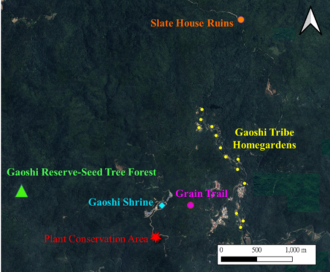
2.1 Plant Survey of Homegardens in Gaoshi Tribe
Home gardens are a form of agroforestry that integrates forestry and agriculture in one area. The Gaoshi people build home gardens near their homes, especially along the Jhonggang River, where they grow vegetables, fruits, and other domestic crops under or around tall forest trees. These gardens grow a variety of indigenous plant species that have cultural significance for the tribe. In addition, they also raise chickens, ducks, geese, pigs, and fish, which provide a source of animal protein to supplement their diet. The plant and animal resources in these home gardens meet the household’s food needs, with the surplus used by the community. These surplus goods can be exchanged through economic transactions or barter systems. This system also plays a role in preserving old cultural practices related to using these resources.
Researchers from the Hengchun TFRI Research Center surveyed over half of the home gardens, covering 20 households. For each household, basic information was collected through interviews, such as the farmer’s age, cultivated area, and farming experience. A comprehensive survey was then conducted to record the types and numbers of all crops and animals and to catalog them. In addition, researchers conducted interviews and documented usage patterns by accompanying farmers to their fields.

2.2 Gaoshi-Named Plants Return to Hometown Work
The residents of the Gaoshi tribe have recognized the importance of ecological conservation and the transmission of cultural knowledge. As a result, they have collaborated with the Tainan Branch ARDSWC to promote the Gaoshi-named plant’s return to hometown work, establishing a plant conservation area for Gaoshi-named plants in the tribe. The goal is to restore the growth of 15 Gaoshi-named plants in the Gaoshi area while also allowing the tribe members and visiting tourists to learn about these plants and their traditional cultural uses. Due to the frequent typhoons and heavy rainfall that impact the Gaoshi tribe, the Tainan Branch ARDSWC placed special emphasis on soil and water conservation when planning the Gaoshi-named plant conservation area. Multiple drainage channels, constructed with cobblestones, were designed to enhance water drainage. The pathways were paved with gravel, allowing rainwater to penetrate and seep into the soil. The natural water resources in the educational area rely solely on rainfall, making the water supply unstable. Two reservoirs, each about 1 meter deep, were excavated within the area to address this. These reservoirs serve as a water source for irrigating the plants and ecological ponds where frogs can reside.
To restore the Gaoshi-named plants, the Tainan Branch ARDSWC consulted with various government and conservation organizations, including the Taiwan Biodiversity Research Institute (TBRI), TFRI, FNCA, and Dr. Cecilia Koo Botanic Conservation Center. The goal was to return the ex-situ conservation results from these organizations to the plants’ original habitats. This vision aligns with the TFRI’s National Botanical Gardens – The Work for Future Green, which focuses on the conservation and restoration of plants. As a result, the two organizations quickly joined forces and collaborated to promote the Gaoshi-named plant’s return to hometown work.
2.3 National Botanical Gardens – The Work for Future Green
TFRI launched the National Botanical Gardens – The Work for Future Green in 2019 to prevent the extinction of Taiwan’s rare and endangered plants. This initiative connects nurseries and botanical gardens across Taiwan to collect, propagate, preserve, and restore plant genetic resources. The work focuses on the ex-situ conservation of native plants, with the goal of later reintroducing them into suitable wild habitats. Hengchun Research Center TFRI is responsible for propagating and restoring tropical plants. It has been involved in the conservation breeding of species such as Syzygium kusukusense, Dysoxylum hongkongense, Leptochilus wrightii, Ardisia kusukuensis, and Eupatorium clematideum var. gracillimum.
When collecting plants, researchers rely on historical herbarium records and literature, as well as citizen science data from platforms like the Taiwan Biodiversity Network (TBN) and iNaturalist. By tapping into the power of the public, they can identify potential habitats for rare plants. TFRI collaborates with government agencies and academic institutions such as FNCA, TBRI, and National Chung Hsing University (NCHU). Together, they share information on the collection of native plant germplasm in Taiwan and exchange plant specimens for planting at their respective restoration sites, thereby enhancing the ex-situ protection efforts for endangered plants.
2.4 Under Forest Economy
The devastating Typhoon Morakot on August 8, 2009, severely impacted the Gaoshi tribe. Many young people returned to support the efforts during the community’s rebuilding process. By 2023, 21 youths had returned to the Gaoshi tribe to participate in rural revitalization initiatives. These young people have developed their expertise in various fields and work closely with the tribe, each contributing to specific areas of collaboration. One of the works they have jointly promoted is the under-forest economy. The under-forest economy refers to utilizing the forest floor’s environmental characteristics to produce appropriate forest byproducts without interfering with the growth of trees or harming the environment. Currently, the under-forest economy initiatives in the Gaoshi tribe include log-grown shiitake mushrooms, Kusukusu eupatorium herbal tea, herbal bath packs, and under-forest beekeeping. Tribe members have planned and established a forest economy demonstration area in the corner of the Gaoshi-named plant conservation area, creating an industry chain based on traditional tribal knowledge.
(1) Log grown shiitake mushrooms
Log-grown shiitake mushrooms were once an important economic product for the Gaoshi tribe. To revive this tradition, the tribe established a shiitake mushroom spawn center dedicated to preserving and cultivating mushroom strains to prevent strain weakening. The logs used for cultivation are prepared by cutting branches rather than whole trunks. Various tree species, such as ring-cupped oak (Quercus glauca), Formosan sweet gum (Liquidambar formosana), and acuminate leaved chinkapin (Castanopsis indica), are used for growing shiitake mushrooms. Visitors to Gaoshi can enjoy the fun of harvesting log-grown shiitake mushrooms and tasting flavorful dishes from them.
(2) Kusukusu eupatorium herbal tea
Kusukusu eupatorium and sword brake (Pteris ensiformis), brewed into a drink, are traditional and unique cultural offerings of the Gaoshi tribe. The tribe’s youth dry these two plants and package them into tea bags, promoting this distinctive beverage to the public. They have also developed innovative dishes incorporating this drink, such as the Kusukusu eupatorium tea egg, a specialty dish showcasing the plant’s unique flavors.
(3) Herbal bath packs
The herbal bath packs are made by drying the leaves of thatch pandanus, three-leaved acanthopanax, and pomelo. These three spiny plants have traditionally been used in Gaoshi tribe culture to drive away evil spirits, and bathing with them is believed to purify the body and dispel negativity. Additionally, pomelo leaves are regarded in traditional Chinese medicine for their antiviral and anti-inflammatory properties. By preserving the wisdom of their ancestors, the tribe has transformed these plants into bath packs that not only remove bad energy from daily life but also promote relaxation, refresh the body and mind, and enhance beauty with their fragrant aroma.
(4) Ruby forest honey
In the past, the Gaoshi tribe had experience with beekeeping. The residents would weave boxes from the leaves of beautiful galangal and hang them on trees to serve as beehives. In 2019, the tribe officially launched its under-forest beekeeping venture. The bees gather nectar from various plants surrounding the Gaoshi tribe, infusing the honey with a unique local flavor. In addition to producing high-quality honey, the tribe collaborates with local young beekeepers to offer a Gaoshi beeswax lip balm DIY experience, where visitors can make their own lip balm using locally sourced beeswax. This provides an opportunity for tourists to directly experience the process of making products from underground forest economic resources.
2.5 Ecotourism
The Gaoshi tribe is located in the mountains and has limited economic development. However, this has allowed the area to retain its rich natural ecological resources. The tribe has combined this natural characteristic with the traditional culture of the Paiwan people to develop ecotourism programs that highlight the local nature, history, and cultural heritage. These tours not only allow visitors to gain a deeper understanding of the Gaoshi tribe’s natural environment and cultural background but also offer them a chance to experience indigenous lifestyles firsthand. Through leading these activities, the younger generation of the tribe becomes more familiar with their community’s natural ecology and traditional culture, helping to promote the Gaoshi tribe’s culture beyond the community while strengthening its roots.
(1) The “grain” trail experience in Gaoshi history
The ancient trail once used by the tribe to transport rice to the fields has been restored and transformed into an excellent location for environmental education. Since the Chinese characters for “古(old)” and “穀(grain)” are identical pronounciation, the trail has come to be known as the “grain” trail. The guide leads visitors along the ancient trail, sharing the history of the path and the surrounding ecology, allowing them to experience the hard work of their ancestors. At the summit, visitors arrive at the Gaoshi Shrine Park, where they walk through a white torii gate to explore the ruins of a Shinto shrine from the Japanese colonial era. From here, they can overlook the bay of Bayao, at the foot of the mountain, while listening to the history of the Gaoshi tribe, including the Mutan Village Incident.
(2) Gaoshi-named plant educational garden walkthrough
Before the tour begins, the spirit medium will lead a prayer and a pass-through fire ritual. After the ritual, participants will wear three-leaved acanthopanax for purification and blessings. This not only offers blessings to the visitors but also showcases the unique plant culture and traditions of the indigenous tribe. Visitors will learn about Gaoshi’s significant contributions to the history of plant surveys in Taiwan and the cultural importance of these plants in the tribe’s traditions. The tour will then continue with an exploration of the current state and development strategies of the tribe’s under-forest economy. If the timing allows, visitors can participate in hands-on activities, such as inoculating shiitake mushrooms onto logs or harvesting them. This immersive experience will provide a deeper understanding of how the tribe integrates natural resources and local knowledge to support sustainable development.
(3) Gaoshi tribe’s traditional wedding
To preserve the tribe’s traditional culture, the community has designed a unique tour experience. Visitors are invited to wear the traditional Gaoshi Paiwan attire, which combines Hakka floral fabric and blue shirts. They will prepare betrothal gifts, including millet, tobacco leaves, betel nuts, betel pepper, and wild boar, and then participate in a mock bride-carrying wedding ceremony. Under the blessing of the tribe’s elders, participants will experience the Gaoshi Paiwan traditional wedding, a centuries-old ritual.
(4) Warrior bento preparation
In the past, before embarking on a journey, the warriors of the Gaoshi tribe were provided with bento made by the women, who wrapped millet and wild boar meat in beautiful galangal leaves as a portable meal. To preserve this traditional culture, the tribe offers an experiential activity where visitors can prepare this traditional dish. The experience also incorporates the cultural practice of pounding mochi, allowing visitors to enjoy the food and gain insight into the hard work involved in food preparation, as practiced by the tribe’s ancestors.
(5) Gaoshi Reserve-seed tree forest ecological tour
Gaoshi Reserve-seed tree forest is home to various rare and precious plants, making it an important site for environmental education. Among its most iconic features is a bishop wood (Bischofia javanica) sacred tree, standing at about 50 meters tall, so massive that it takes 12 people to encircle it. The guided tour offers a glimpse of this majestic ancient tree and an ideal opportunity to learn about the tribe’s natural ecology and culture. This tour allows visitors to learn about ecological conservation and the natural environment. Additionally, the tribe members patrol the forest, reporting any illegal activities to the relevant authorities to help protect and preserve the local ecosystem.
(6) Wild greens flavored cuisine
The Gaoshi tribe has a rich knowledge of wild greens, and through its integration with local homegardens, visitors are introduced to many unique indigenous wild plants. By participating in hands-on activities such as foraging wild greens and preparing traditional tribal meals, participants can experience the beauty of mountain life firsthand, savoring the flavors of nature’s gifts. They also have the opportunity to learn from the tribe’s people about the wisdom of living in harmony with nature. This activity deepens visitors’ understanding of local plants and fosters a profound appreciation for the deep connection between the tribe and the land.
(7) Nocturnal field tour
The Gaoshi tribe is home to a rich nocturnal fauna, particularly notable for its 16 species of frogs, which have inspired many captivating stories and ancient folk songs. During the nighttime ecological tour, visitors can observe a variety of amphibians and reptiles and listen to the chorus of Collared Scops Owls (Otus lettia) and various insects, creating a symphony of sounds orchestrated by nature itself. This immersive exploration offers a deep, intimate connection with the environment, allowing participants to truly appreciate the tribe’s unique ecological beauty and the rich cultural heritage embedded in its traditions.
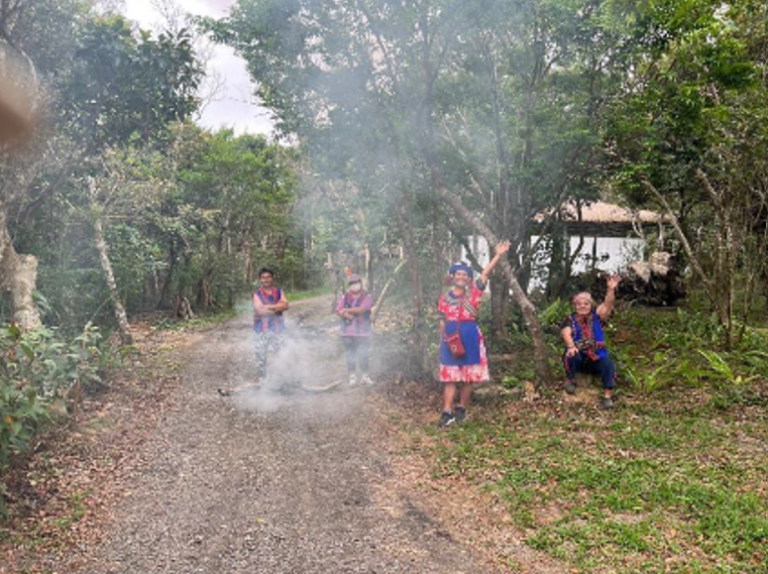
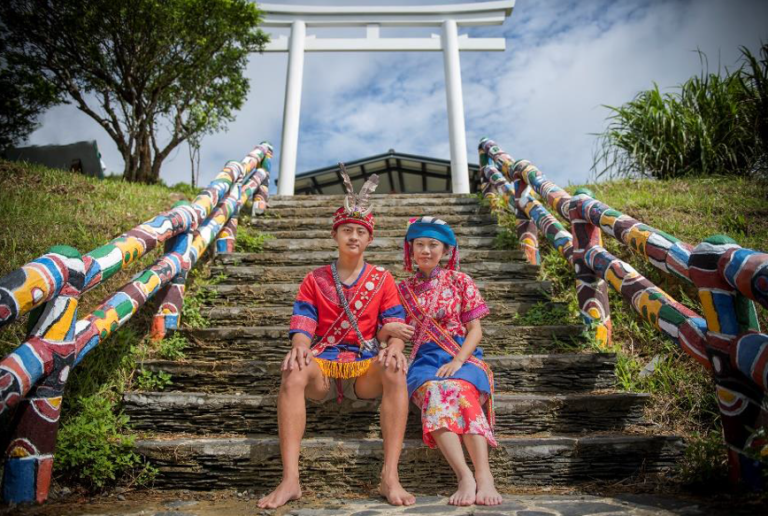
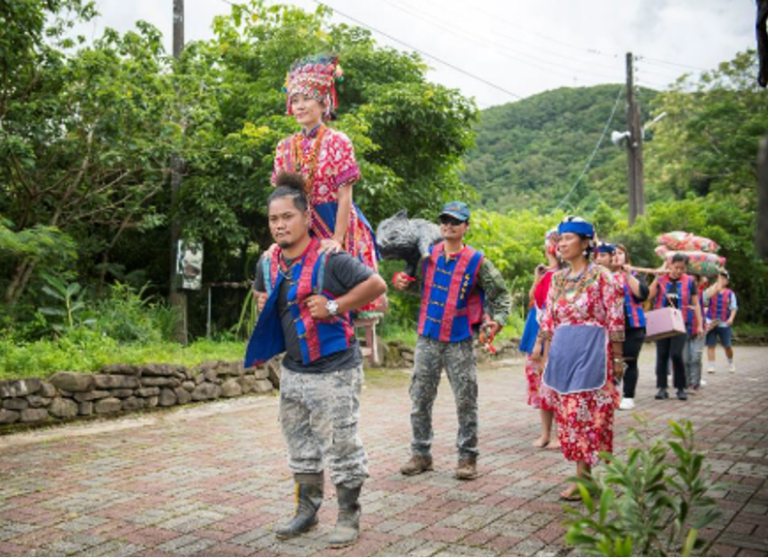
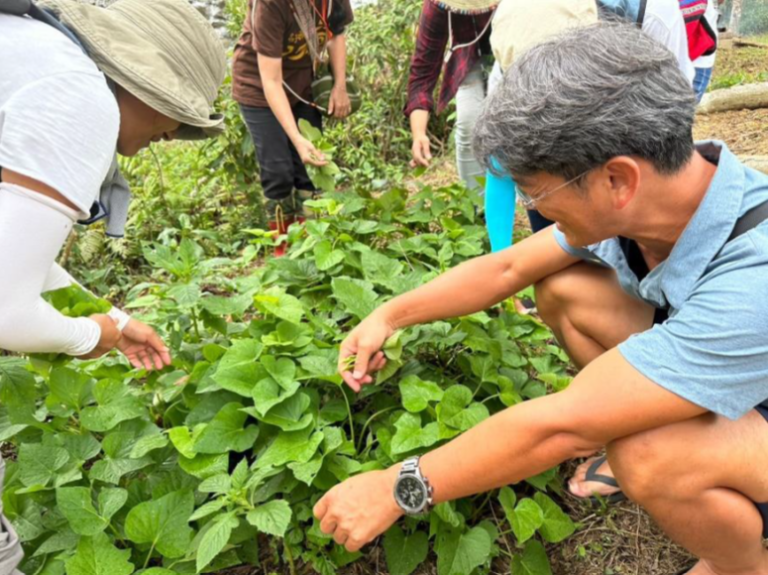
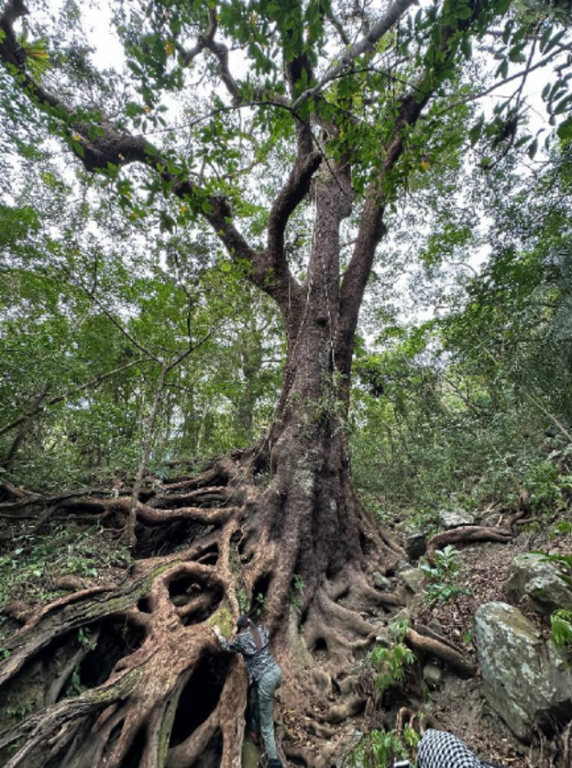
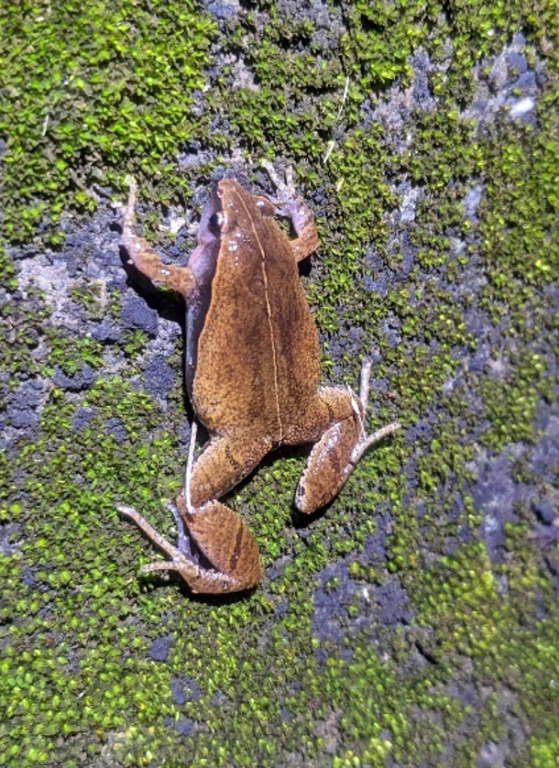
Note: The above photos are provided by the Gaoshi Community Development Association.
3. Results
3.1 Gaoshi Tribe Homegardens Plant Survey
The survey revealed that homegardens in the Gaoshi tribe typically include vegetable gardens, ponds, mushroom cultivation areas, and livestock-raising zones. These homegardens contain over 300 plant species and 10 types of domesticated animals, which can be classified into 13 categories based on their uses: grains, spices, ornamental and fragrant flowers, medicinal plants, fruits, vegetables, shade trees, firewood, craft materials and edible packaging, beverage plants, building materials, special-use plants, and livestock. Among these categories, ornamental and fragrant flowers (177 species), shade trees (99 species), vegetables (72 species), and fruits (46 species) are the most abundant, with all farmers cultivating them. Grains and medicinal plants are less common, with only four species of grains and 11 species of medicinal plants. This is due to challenges in cultivation, easy availability in the market, and the well-developed healthcare system, which significantly influence their presence in homegardens.
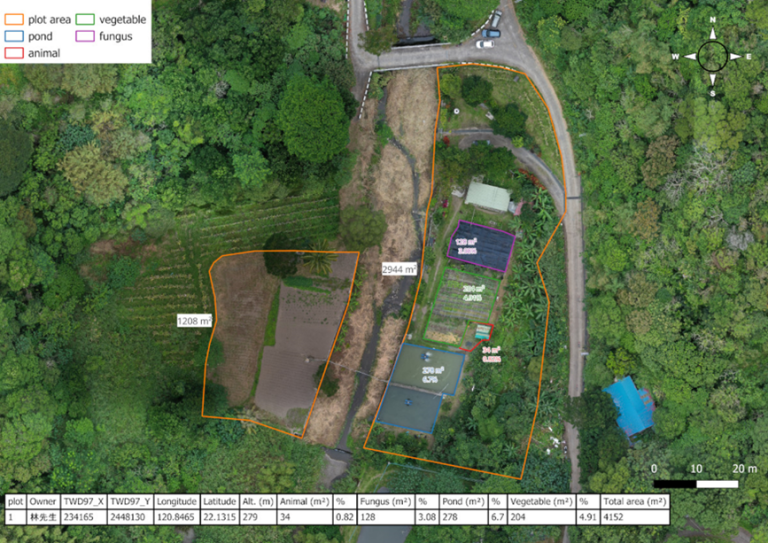
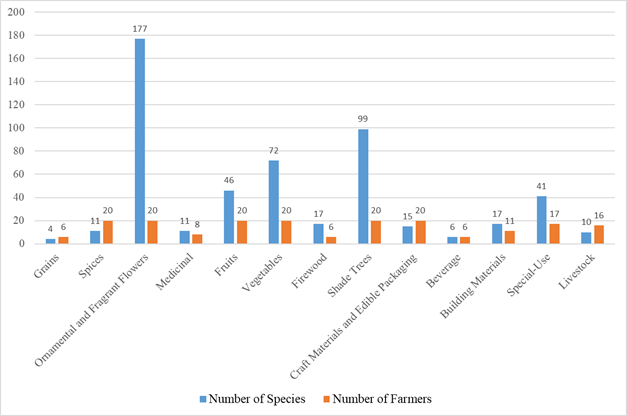
Note: The above data are provided by Researcher Wen-Chin Lin.
Among the vegetable varieties grown, although most are cultivated from purchased seeds and are typically domesticated varieties such as bok choy and eggplant, there are still traditional plants like khasya trichodesma (Trichodesma calycosum) and cow-foot leaf (Piper umbellatum), which hold value for both conservation and cultural heritage. In addition, within the special-use plants category, the tribe possesses specialized expertise in cultivating shiitake mushrooms. The tribe intentionally plants tree species that can be used for shiitake mushroom logs, ensuring a sustainable supply of logs for future generations. Although there are only 11 species among the spice plants, every household grows at least some. Japanese Prickly Ash (Zanthoxylum ailanthoides) is particularly common—18 out of 20 households cultivate it. In addition to being used as a spice, this plant also serves as a vegetable. Its medicinal properties make it a highly distinctive and valuable plant in the local community.
As 95% of the gardeners in the homegardens are over 60 years old, the tribe should actively address issues related to the transmission of both agricultural techniques and cultural heritage. This includes cataloging the various types of plant and animal utilization, along with the cultural stories associated with them. Selecting species that hold significant local importance to the Gaoshi tribe can be valuable resources for cultural creation or tourism interpretation, helping preserve and promote the tribe’s unique heritage.
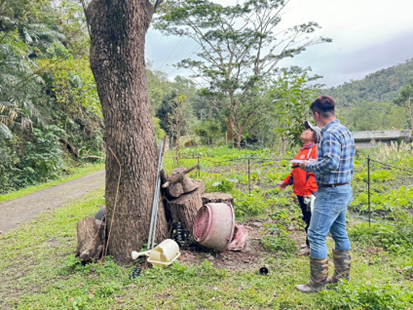
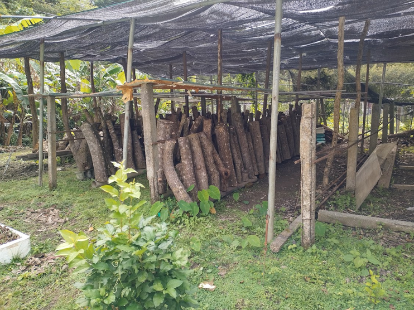
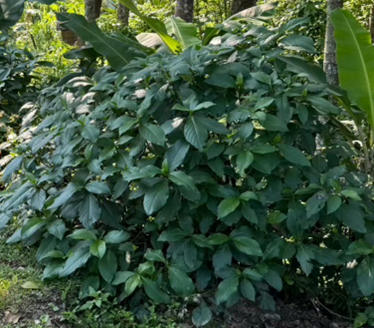
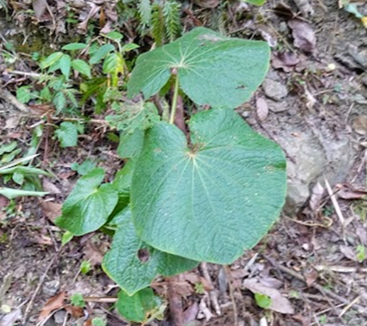
Note: The above photos are provided by Researcher Wen-Chin Lin.
3.2 Gaoshi-named Plant Restoration Methods
From an educational and display perspective, showcasing the 15 vascular plants named after Kaoshifo would be a captivating highlight. Furthermore, different ecological environments could be simulated if a small-scale area could be created that takes advantage of the varying light, temperature, and humidity conditions inside and outside the forest. With human intervention, such as artificial greenhouses and diverse growth substrates, creating more suitable habitats for these plants to thrive would be possible. This is not a far-fetched dream; with passionate manpower, adequate investment, and professional guidance, bringing this vision to life and presenting these Gaoshi-named plants to the public is feasible.
From an ecotourism perspective, viewing the Gaoshi mountain area as a whole and creating stops at different ecological environments where various combinations of Gaoshi-named plants can be displayed would add uniqueness to the interpretation and reduce the complexity of implementation. After all, all Gaoshi-named plants are native species suited to the local environment, and once the conditions are right, spontaneous flourishing and growth can be expected.
Several important steps need to be taken to achieve this goal, including seed collection (which involves collecting live plants as well as sexual and asexual propagules), cultivation, propagation, acclimatization (steps to help seedlings adapt or survive adverse conditions before field restoration), and restoration (in this case, focusing on local restoration). All of these steps are essential. In addition, a nursery greenhouse capable of accommodating and providing proper care for many seedlings is necessary to ensure a continuous supply of live plants for field restoration.
In-situ restoration is one of the key objectives of this work, and it is closely linked to in-situ conservation. In regions disturbed by human activity, where the original vegetation no longer exists, introducing suitable Gaoshi-named plants and other associated native plants for restoration is considered in restoration. In contrast, in-situ conservation involves protecting existing, minimally disturbed areas and preserving native ecosystems from further human interference and degradation.
When examining the current status of various Gaoshi-named plants, the restoration strategies can generally be classified into the following six categories:
(1) Gaoshi area still hosts species that are relatively common and are not at risk of rare or endangered conservation status.
Species such as Tectaria kusukusensis (LC), Leptochilus wrightii (LC), Bulbophyllum affine (LC), Diploprora championii (LC), and Syzygium kusukusense (LC) are among those that can be found in the Gaoshi mountain area, though they each have very different habitat preferences. For educational displays, landscape creation, or even vegetation restoration, planting should be done based on the specific environmental preferences of each species.
Regarding the acquisition of restoration seedlings, Syzygium kusukusense can be propagated through seeds for mass cultivation in pots, which has a high survival rate. For the other four species, as the local populations are relatively abundant, it is recommended to directly collect a suitable number of live plants for in-situ planting (species like Bulbophyllum affine and Diploprora championii, which are lithophytic or epiphytic, should be considered). Alternatively, planting can begin in greenhouses (especially for Tectaria kusukusensis), and once the plants have stabilized, they can be transplanted into the wild. For ferns, if a large quantity is needed, spores can be used for propagation, though the growing process typically takes at least a year (depending on the species), which can be time-consuming. Additionally, when conducting in-situ plant restoration, intentionally planting seedlings at appropriate intervals within a designated area to increase plant density may help promote cross-pollination and enhance genetic diversity, thereby accelerating the establishment of a stable community.
(2) Species in the Gaoshi area are still considered relatively common but are classified as vulnerable species.
The plants in this category include Eupatorium clematideum var. gracillimum (VU) and Ardisia kusukuensis (VU), both of which are not uncommon in the Gaoshi area and surrounding regions (such as the Hengchun Peninsula) but are found only in these areas throughout Taiwan. For seedling cultivation, both species can be propagated from seeds. Eupatorium clematideum var. gracillimum can also be propagated through cuttings to increase plant numbers. As for restoration methods, it is essential to follow the principle of “Right place, right plants” and refer to the guidelines outlined in section (1) for implementation.
(3) TheGaoshi area has small populations of these species, primarily found in southern and southeastern Taiwan, and their cultivation is relatively straightforward.
These species, represented by Lindsaea lucida (VU) and Dysoxylum hongkongense (LC), are not commonly found in the Gaoshi mountain area. However, due to their significant ecological differences, their restoration strategies should be addressed separately. Lindsaea lucida is typically found in crevices near stream valleys (such as in Mudan Pond Mountain) or hillside environments (such as Shouka) and rarely forms dense clusters. While it can be propagated from spores and successfully cultivated in greenhouses, its narrow ecological amplitude means that transplanting it to non-ecologically suitable display areas would likely result in a high mortality rate. Moreover, although the Lindsaea lucida population is small, as long as the stream valley environment remains undisturbed, the species is not at risk of extinction. Therefore, the focus should be protecting the stream valley environment and promoting ecological conservation rather than direct species restoration.
Meanwhile, Dysoxylum hongkongense is not abundant and is scattered across the forest, it can be difficult to locate. However, if seeds are successfully collected, there is a high chance of successful cultivation. Additionally, vegetative propagation through branch cuttings could also be considered as an option.
(4) Endangered plants with very small populations and pose certain challenges in cultivation.
This group of plants includes Liparis somai (EN), Oberonia kusukusensis (DD), Thrixspermum merguense (EN), and Glochidion kusukusense (LC). The first three, all orchids, are epiphytic plants that grow in mid-to-high positions on trees. Given the current rarity of their wild populations, it is likely that these species face reproductive limitations, so prioritizing the conservation of their ecological habitats should be the main focus. For those that require cultivation for educational displays, it is recommended to collect a small number of specimens from the wild, grow them in a greenhouse until they are stable, and then propagate them through division as they grow. This approach should be feasible.
Glochidion kusukusense, a shrub or small tree, is known to be found in only 3-4 locations in Taiwan, making it quite rare, and in-situ restoration is necessary. However, its conservation status is rated as Least Concern (LC), which may be an underestimation of its rarity. According to field observations, the plant’s annual fruiting rate is unstable. In addition to seed propagation, increasing the number of plants through cuttings could be another viable method.
(5) Plants that are extremely difficult to cultivate artificially.
Epipogium roseum (LC) is commonly found in the sparse broadleaf or bamboo forests at low elevations in central and southern Taiwan. Although it is not a rare species, its status as a mycoheterotroph, relying on a specific symbiotic relationship with decomposing fungi, makes artificial cultivation extremely difficult. Conservation of its habitat should be the primary focus, rather than an emphasis on plant propagation.
(6) Other
Boehmeria densiflora form. “Noble Buddha” (DD) is a rare cultivar of the dense-flowered false nettle (Boehmeria densiflora). It is known to be found only in its type locality in the Gaoshi mountain area. Its habitat requirements and reproductive methods are likely similar to dense-flowered false nettle, with the main challenge in restoration being the difficulty locating the plants.
3.3 Gaoshi-Named Plants Return to Hometown
Thanks to the efforts of the tribal members and various organizations, on November 29, 2022, the Gaoshi tribe, Tainan Branch ARDSWC, and Hengchun Research Center TFRI collaborated on the “Gaoshi-Named Plants Return to Hometown Work”. This initiative aimed to return Gaoshi-named plants, which had been preserved in other locations, back to their original homeland. Through the planting of these plants, the work sought to achieve both cultural heritage preservation and the restoration of biodiversity. On that day, a total of 54 plants from 9 different Gaoshi-named species were returned to the tribe, including Ardisia kusukuensis (5 plants), Syzygium kusukusense (12 plants), Eupatorium clematideum var. gracillimum (9 plants), Dysoxylum hongkongense (7 plants), Lindsaea lucida (1 pot), Tectaria kusukusensis (6 pots, 8 plants), Leptochilus wrightii (4 pots), Bulbophyllum affine (5 plants), and Diploprora championii (3 plants). Among them, the more robust species, Eupatorium clematideum var. gracillimum and Ardisia kusukuensis, were planted directly in the field, while the remaining Gaoshi-named plants were placed in the tribe’s plant conservation area for acclimatization, with efforts to conserve and propagate them locally.
To help the tribal members better understand these Gaoshi-named plants, researchers from the Hengchun Research Center TFRI organized courses to introduce the identification features, habitat characteristics, and distribution of each species. They also taught the tribe members to plant care knowledge and simple propagation methods, enabling them to independently care for the plants in the garden and continue to propagate more Gaoshi-named plants through methods like cutting or seed planting. Meanwhile, the elders of the tribe can use these plants as tangible examples to explain and even demonstrate the traditional uses of Gaoshi-named plants to the younger generation. For example, they can show how Dysoxylum hongkongense is used as a material for furniture, how Syzygium kusukusense is carved into mortar, and how Kusukusu eupatorium and sword brake are boiled into herbal tea. This allows the cultural knowledge of the tribe to be passed down to future generations.
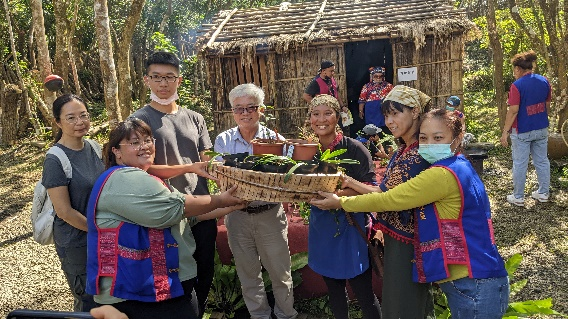
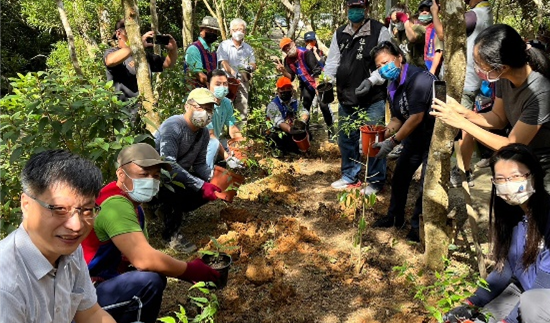
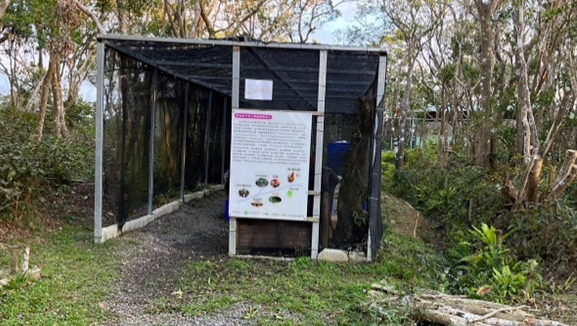
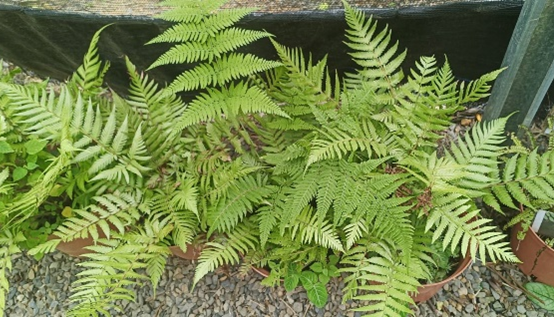
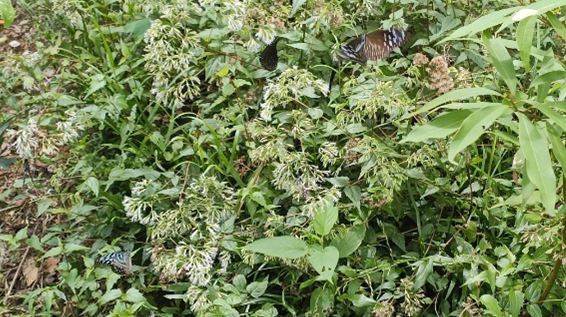
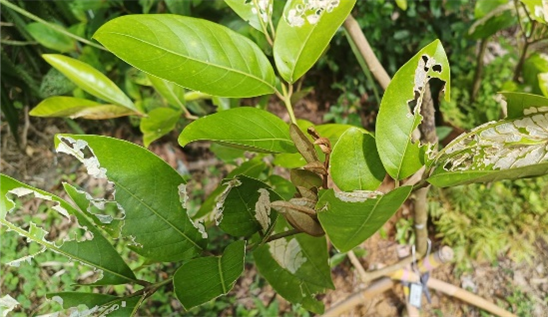
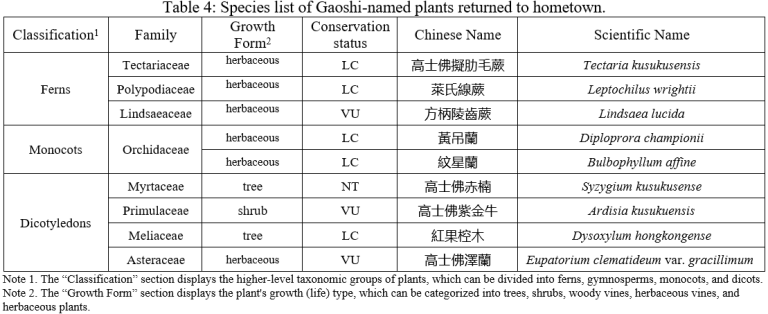
3.4 The Benefits of Gaoshi-named Plant Restoration
Plant restoration not only helps maintain biodiversity and build healthy ecosystems, but it also plays a crucial role in social and economic development. Take kusukusu eupatorium as an example. This plant serves as an important nectar source for many butterfly species (such as species in the Danaus, Tirumala, and Euploea genera). The pyrrolizidine alkaloids (PAs) in its nectar help male butterflies synthesize the pheromone “Danaidone.” Moreover, the kusukusu eupatorium is also a traditional beverage plant in the Gaoshi community. The tea bags and related products made from this plant serve as one of the community’s economic sources, contributing to the livelihoods of local families. Recent studies have shown that the secondary metabolites of Kusukusu eupatorium hold promise for the development of anti-cancer drugs (Fang & Lin, 2022; Tran, 2024), and the tribe is currently exploring its use in developing mosquito repellent products.
Multiple lines of evidence highlight this plant’s significant ecological, cultural, and economic value. However, the wild populations of Kusukusu eupatorium have been severely affected by overharvesting, leading to a steady decline in their numbers. This situation underscores the importance of the Gaoshi Plant Return Work. In addition to returning the Kusukusu eupatorium to the tribe to help preserve biodiversity, the work also teaches the tribe members how to propagate the plant through seeds and cuttings, and how to care for it. This ensures that Kusukusu eupatorium can thrive and flourish in its native habitat for generations.
Many plants, in addition to their ecological functions, also possess potential for development. However, many of these plants have become rare before their full range of benefits has even been discovered. Only through effective restoration programs and protective measures can we ensure that these plants survive and that their multifaceted value is preserved for future generations.
4. Lessons learned
4.1 Gaoshi-named Plant Restoration Initiative
Through collaborative efforts between the Tainan Branch of ARDSWC and the Hengchun Research Center of TFRI, the Gaoshi tribe successfully reintroduced and planted nine plant species named after Gaoshi in their garden. Tribal members actively participated in the restoration efforts of these plants and have successfully propagated the Eupatorium kusukusu species through cuttings and seedling methods. The domesticated Syzygium kusukusense and Dysoxylum hongkongense have also been planted in the conservation area. These plants returned to their native habitat and are growing well. Notably, kusukusu eupatorium and Ardisia kusukuensis have already shown signs of natural fruiting. Hengchun Research Center TFRI continues to guide plant care knowledge and assists in monitoring the growth status of the returned plants.
The Gaoshi-named plant return to hometown work is ongoing, with plans to reintroduce the remaining six species of Gaoshi-named plants back into the tribe. Through the team’s efforts, researchers from the Liouguei Research Center TFRI found several Glochidion kusukusense plants in Eighteen Arhats Mountain, Liouguei, Kaohsiung, in 2024. However, monitoring after the discovery revealed that the plants, although flowering, did not bear fruit, possibly due to the impact of a typhoon in July. As a result, the team is now attempting to propagate the plants through cuttings. Once the plants have reached a sufficient size, they will be transplanted back to the Gaoshi tribe.
Meanwhile, the Hengchun Research Center TFRI has also successfully located the rare Liparis somai, bringing the total number of Gaoshi-named plants found to 11 species. These plants not only hold significant ecological value but also have deep cultural meanings for the tribe. The work will continue to support the Gaoshi tribe’s biodiversity and the transmission of traditional plant usage, aiming to restore the SEPLS and achieve environmental, social, and economic balance.

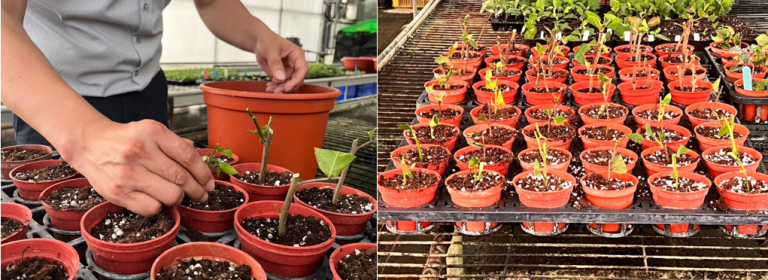
Note: The above materials were filmed and produced by our team.
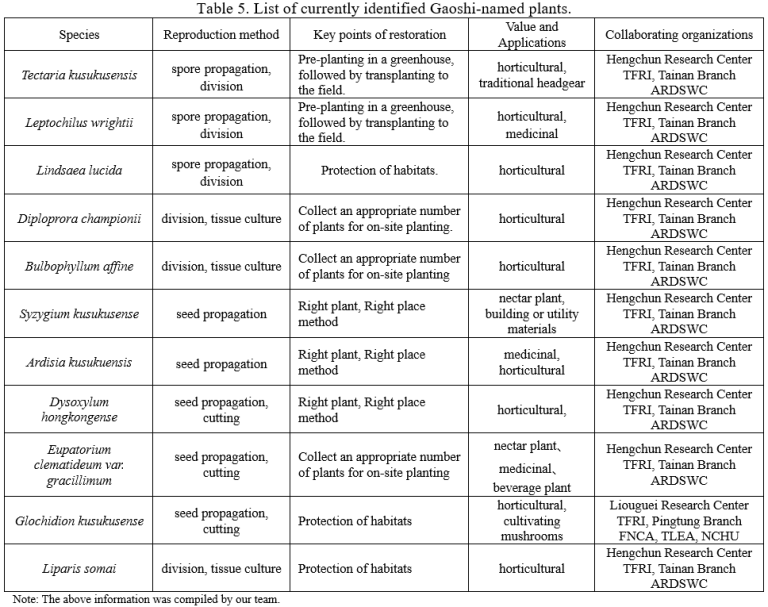
4.2 Cross-disciplinary Collaboration in Plant Restoration Program
This work established five key steps through collaboration among different organizations. The first step is to locate plant sources, divided into two areas: the indigenous territory of the Gaoshi tribe and non-Gaoshi village regions. Since the indigenous territory is an area well-known to the Gaoshi people, they can traverse the steep mountains and dense forests to search for Gaoshi-named plants carefully. Many of the plants also grow in areas outside the Gaoshi region. TFRI and Taiwan Landscape Environment Association (TLEA) collaborate by reviewing literature and searching open ecological data from platforms like iNaturalist or Taiwan Biodiversity Network (TBN) to analyze potential locations where Gaoshi-named plants may be found. Once Gaoshi-named plants are confirmed, professional personnel from TFRI and FNCA will collect seeds or cuttings of the plants to facilitate subsequent sexual or asexual reproduction.
The third step of plant propagation is primarily carried out by the Hengchun Research Center TFRI, with a small portion of the propagation work handled by the Department of Horticulture at National Chung Hsing University (NCHU). Once a sufficient number of plants have been successfully propagated, preparations can begin to return them to the Gaoshi tribe. However, plants propagated in a different environment (e.g., greenhouse cultivation) do not experience the same conditions as their native habitats. To increase the survival rate of the plants when reintroduced to the tribe, they must first undergo acclimatization to adapt to the new environment slowly. Tainan Branch ARDSWC has organized a plant restoration base for the Gaoshi tribe, providing a centralized location where the returning Gaoshi-named plants can acclimate. Local residents are responsible for caring for these plants during this process. Once acclimatized, the plants are ready to be planted back into the land of Gaoshi. Most plants are planted in the conservation area, where tribe members introduce them to visitors. Some plants are also transplanted along roadsides, trails, forest areas, and homegardens, integrating them into the daily lives of the tribe members.

4.3 Gaoshi Culture Knowledge Co-production, Management and Uptake
Folk plants play a very important role in the culture and history of the Paiwan people in the Gaoshi tribe. They are not only practical resources in daily life but also symbols of culture, beliefs, and history. However, with the increasing convenience of modern life, the distance between the tribe’s residents and folk plants gradually grew, and some even disappeared from daily life. Gaoshi-named plant return to hometown work, which initiates plant conservation and restoration actions, not only brings the lost plants back to the tribe but also awakens the tribe’s awareness of folk plants. In the plant conservation area, young tribe members learn the indigenous names and traditional uses of plants through interviews with elders, preserving cultural knowledge. They also engage in under-forest economies such as beekeeping and growing shiitake mushrooms within the area, creating a sustainable industry chain based on traditional knowledge. The plant conservation area has been developed as a demonstration area for plant restoration and product development, serving as one of the key eco-tourism destinations in the tribe and showcasing the symbiotic relationship between the Gaoshi tribe and nature, as well as their shared culture. In addition to passing on the Gaoshi plant culture and life wisdom, elders also experience the calming and health-promoting benefits of caring for plants, contributing to green care for their well-being. The entire plant conservation area blends modern technology with traditional knowledge, becoming a learning base for all generations—elderly, middle-aged, and young—within the Gaoshi tribe and reconstructing a complete social and economic system.
These efforts fully embody the spirit of the Kunming-Montreal Global Biodiversity Framework in protecting indigenous traditional knowledge. In particular, this work follows Action Target 22, ensuring the full participation of the tribe’s residents in the decision-making process and guaranteeing that they receive fair benefit-sharing in biodiversity conservation and resource utilization. Through these actions, the folk plant culture of the Gaoshi tribe is revived and passed down, and the tribe’s SEPLS landscapes are restored, allowing the Southern Paiwan Ruby to shine once again.
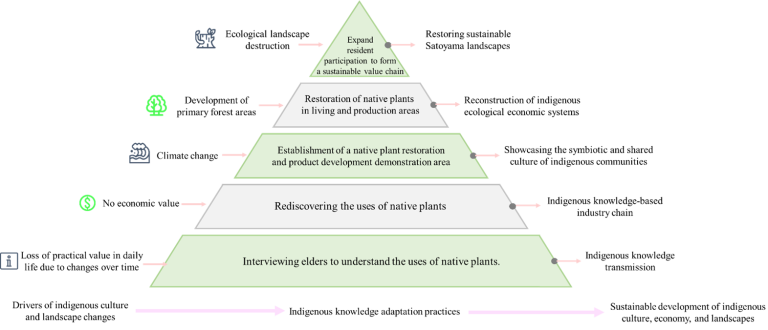
5. References
- Fang, R. Y., Lin, Y. S. (2022). Study on Active Terpenoids and Cytotoxicity from Formosan Eupatorium clematideum. Veterans Affairs Council, basic research.
- Taiwan Biodiversity Information Alliance (2024). Retrieved November 11, 2024 from https://tbiadata.tw/zh-hant/search/occurrence.
- Taiwan Biodiversity Network (2024). Retrieved November 11, 2024 from https://www.tbn.org.tw/topic/species_richness.
- Hu, C. Y. (2001). The Short Term Adjustment Strategy of the Agricultural Activities to Season Wind in Hengchun Area, Taiwan. Geographical Research, no. 34, pp. 1-34.
- Gaoshi Village Rural Regeneration Program (2011). Report of the rural regeneration program application. Pingtung County Government.
- Mudan Township Office (2022). Retrieved November 25, 2022 from https://www.pthg.gov.tw/townmdt/News_Content.aspx?n=C20E020DF76BD0FF&sms=2715FDF194911C1A&s=C5A7FBFFD012E618.
- Council of Indigenous Peoples (2023). Retrieved November 18, 2023 from https://www.cip.gov.tw.
- Tran, L. M. H. (2024). Analysis and Research on the Chemical Components from the Flower of Taiwanese Eupatorium clematideum (Wall. ex DC.) Sch. Bip. var. gracillimum. Master Thesis, Meiho University, Pingtung County.
- Chang, H. J. (2022). idu lja vuvu: A Study of Ritual and Music in “Icacevung” Ceremony of Kuskus Tribe of Paiwan People. Master Thesis, National Taiwan Normal University, Taipei City.
- Hsu, C. L., Yan, H. Y., Hsieh, I. l., Huang, H. C. (2012). Investigation of Potential Landslide Disaster on Above Tribal of Kaoshih Village, Mudan Township. Journal of Slopeland Hazard Prevention, vol. 11, no. 2, pp. 14-23.
- Huang, S. P., Yeh, D. H., Hsieh, C. F. (2006). Ecological Characteristics of the Nanjenshan Forest Dynamics Plot. Forestry Research Newsletter, vol. 13, no. 2, pp. 16-18.
- Lu, T. H., Ke, Y. N., Lin, S. F., Lu, S. Y. (2011). Plants Used by Paiwan in Taiwan. Forestry and Nature Conservation Agency, Ministry of Agriculture (MOA), Taipie City.
- Yang, C. K., Chang, Y. H., Huang, L. Y., Papalicang, T., Papalicang, V., Chen, M. H. (2024). Kusukusu: a place full of flora mystery in Hengchun Peninsula. Nature Conservation Quarterly, no. 125, pp. 20-37.
- Su, C. C. (2008). Chemical Constituents and Bioactivities from Ardisia kusukuensis. Master Thesis, Kaohsiung Medical University, Kaohsiung City.
- Editorial Committee, the Red List of Vascular Plants of Taiwan (2017). The Red List of Vascular Plants of Taiwan, 2017. Taiwan Biodiversity Research Institute MOA, Forestry and Nature Conservation Agency MOA, Taiwan Society of Plant Systematics, Nantou County.
- Cheng, H. W., Wang, H. H., Cheng, H. F., Lai, H. Y. (2005). Ethnobotanical Plants of Paiwan Tribe. Taiwan Forestry Research Institute, MOA, Taipei City.
- Zhuo, X. J. (2017). The Survey and Practice of Indigenous Plant Applications in Gaoshi Tribe. Taiwan Indigenous Community Service Grant Program, Final Report, Institute of Ethnology, Academia Sinica.
- Lu, S. Y., Huang, W. S., Shih, B. L. (1999). New Cultivars from Native Plants of Taiwan (Ⅲ). Taiwan Journal of Forest Science, vol. 14, no. 4, pp. 509-511.
6. Appendix
Appendix 1: List of species of Gaoshi Village
Note: *Endemic species, #Endemic subspecies, Protected Wildlife (PW), Endangered (EN), Vulnerable (VU), Near Threatened (NT), invasive alien species (IAS)
Birds 鳥類
- Accipitridae 鷹科 (7 species)
- Accipiter soloensis 赤腹鷹(PW, NT)
- Accipiter trivirgatus formosae 鳳頭蒼鷹#(PW)
- Butastur indicus 灰面鵟鷹(PW)
- Ictinaetus malaiensis 林鵰(PW, NT)
- Milvus migrans 黑鳶(PW, VU)
- Pernis ptilorhynchus 東方蜂鷹(PW, NT)
- Spilornis cheela hoya 大冠鷲 #(PW)
- Alcedinidae 翠鳥科 (1 species)
- Alcedo atthis 翠鳥
- Anatidae 雁鴨科 (1 species)
- Anas zonorhyncha 花嘴鴨
- Apodidae 雨燕科 (2 species)
- Apus nipalensis 小雨燕
- Hirundapus cochinchinensis 灰喉針尾雨燕
- Ardeidae 鷺科 (2 species)
- Egretta garzetta 小白鷺
- Gorsachius melanolophus 黑冠麻鷺
- Campephagidae 山椒鳥科 (1 species)
- Pericrocotus solaris 灰喉山椒(NT)
- Corvidae 鴉科 (2 species)
- Dendrocitta formosae formosae 樹鵲 #
- Urocissa caerulea 臺灣藍鵲*
- Dicaeidae 啄花科 (1 species)
- Dicaeum minullum 綠啄花
- Dicruridae 卷尾科 (1 species)
- Dicrurus aeneus 小卷尾
- Falconidae 隼科 (1 species)
- Falco peregrinus 遊隼(PW)
- Hirundinidae 燕科 (2 species)
- Hirundo rustica 家燕
- Hirundo tahitica 洋燕
- Leiothrichidae 噪眉科 (2 species)
- Alcippe morrisonia 繡眼畫眉*
- Heterophasia auricularis 白耳畫眉*(PW)
- Megalaimidae 鬚鴷科 (1 species)
- Psilopogon nuchalis 五色鳥*
- Monarchidae 王鶲科 (1 species)
- Hypothymis azurea oberholseri 黑枕藍鶲#
- Motacillidae 鶺鴒科 (1 species)
- Motacilla alba 白鶺鴒
- Muscicapidae 鶲科 (2 species)
- Phoenicurus auroreus 黃尾鴝
- Myophonus insularis臺灣紫嘯鶇*
- Phasianidae 雉科 (3 species)
- Arborophila crudigularis 臺灣山鷓鴣*(PW)
- Bambusicola sonorivox 臺灣竹雞*
- Lophura swinhoii 藍腹鷴*(PW)
- Phylloscopidae 柳鶯科 (1 species)
- Phylloscopus inornatus 黃眉柳鶯
- Picidae 啄木鳥科 (1 species)
- Yungipicus canicapillus 小啄木
- Pycnonotidae 鵯科 (2 species)
- Hypsipetes leucocephalus nigerrimus 紅嘴黑鵯#
- Pycnonotus taivanus 烏頭翁*(PW, VU)
- Strigidae 鴟鴞科 (2 species)
- Otus lettia 領角鴞(PW)
- Otus spilocephalus 黃嘴角鴞(PW)
- Timaliidae 畫眉科 (3 species)
- Cyanoderma ruficeps praecognitum 山紅頭#
- Erythrogenys erythrocnemis 大彎嘴*
- Pomatorhinus musicus 小彎嘴*
- Turdidae 鶇科 (2 species)
- Turdus chrysolaus 赤腹鶇
- Turdus pallidus 白腹鶇
- Vireonidae 綠鵙科 (1 species)
- Erpornis zantholeuca 綠畫眉
- Zosteropidae 繡眼科 (1 species)
- Zosterops simplex 斯氏繡眼
Mammals 哺乳類
- Bovidae牛科 (1 species)
- Capricornis swinhoei臺灣野山羊*(PW, NT)
- Cervidae鹿科 (1 species)
- Muntiacus reevesi micrurus臺灣山羌#
- Suidae豬科 (1 species)
- Sus scrofa taivanus臺灣野豬#
- Herpestidae獴科 (1 species)
- Herpestes urva formosanus 食蟹獴#(PW, NT)
- Mustelidae 貂科 (1 species)
- Melogale moschata subaurantiaca 鼬獾#
- Viverridae 靈貓科 (1 species)
- Paguma larvata taivana白鼻心#
- Leporidae 兔科 (1 species)
- Lepus sinensis 臺灣野兔#
- Manidae 穿山甲科 (1 species)
- Manis pentadactyla pentadactyla 穿山甲# (PW, VU)
- Cercopithecidae 獼猴科 (1 species)
- Macaca cyclopis 臺灣獼猴*
- Rhinolophidae 蹄鼻蝠科 (1 species)
- Rhinolophus monoceros 臺灣小蹄鼻蝠*
- Hipposideridae 葉鼻蝠科 (1 species)
- Hipposideros armiger 臺灣葉鼻蝠
- Vespertilionidae 蝙蝠科 (3 species)
- Kerivoula furva 玄彩蝠
- Myotis frater 長尾鼠耳蝠
- Myotis fimbriatus taiwanensis臺灣毛腿鼠耳蝠#
- Muridae 鼠科 (4 species)
- Niviventer coninga 臺灣刺鼠*
- Rattus losea 小黃腹鼠
- Rattus norvegicus 溝鼠
- Mus caroli 田鼷鼠
- Sciuridae 松鼠科 (2 species)
- Callosciurus erythraeus thaiwanensis 赤腹松鼠#
- Petaurista philippensis grandis 大赤鼯鼠#
- Soricidae 尖鼠科 (2 species)
- Suncus murinus 臭鼩
- Crocidura tanakae 臺灣灰麝鼩*
Reptiles 爬行類
- Agamidae 飛蜥科 (1 species)
- Diploderma swinhonis 斯文豪氏攀蜥*
- Colubridae 黃頷蛇科 (6 species)
- Oligodon formosanus 赤背松柏根
- Psammodynastes pulverulentus 茶斑蛇
- Ptyas major 青蛇
- Lycodon rufozonatus紅斑蛇
- Ptyas dhumnades過山刀
- Elaphe carinata王錦蛇
- Gekkonidae 壁虎科 (2 species)
- Gekko hokouensis 鉛山壁虎
- Hemidactylus frenatus 疣尾蝎虎
- Scincidae 石龍子科 (1 species)
- Sphenomorphus indicus 印度蜓蜥
- Typhlopidae 盲蛇科 (1 species)
- Indotyphlops braminus 鉤盲蛇
- Viperidae 蝮蛇科 (3 species)
- Trimeresurus stejnegeri 赤尾青竹絲
- Deinagkistrodon acutus百步蛇(PW)
- Protobothrops mucrosquamatus龜殼花
- Elapidae蝙蝠蛇科 (1 species)
- Bungarus multicinctus雨傘節
- Lacertidae正蜥科 (2 species)
- Takydromus formosanus臺灣草蜥*
- Takydromus sauteri梭德氏草蜥*(PW)
- Geoemydidae地龜科 (2 species)
- Cuora flavomarginata食蛇龜(PW, VU)
- Mauremys sinensis斑龜
- Trionychidae鱉科 (1 species)
- Pelodiscus sinensis中華鱉
Amphibians 兩棲類
- Bufonidae 蟾蜍科 (2 species)
- Duttaphrynus melanostictus 黑眶蟾蜍
- Bufo bankorensis盤古蟾蜍*
- Dicroglossidae 叉舌蛙科 (2 species)
- Fejervarya limnocharis 澤蛙
- Hoplobatrachus rugulosus 虎皮蛙
- Microhylidae 狹口蛙科 (2 species)
- Microhyla fissipes 小雨蛙
- Microhyla heymonsi 黑蒙西氏小雨蛙
- Ranidae 赤蛙科 (2 species)
- Hylarana latouchii 拉都希氏赤蛙
- Nidirana adenopleura 腹斑蛙
- Rhacophoridae 樹蛙科 (7 species)
- Buergeria choui 周氏樹蛙
- Buergeria otai 太田樹蛙
- Kurixalus wangi 王氏樹蛙*
- Polypedates braueri 布氏樹蛙
- Polypedates megacephalus 斑腿樹蛙(IAS)
- Zhangixalus moltrechti 莫氏樹蛙*
- Buergeria robusta褐樹蛙*
Fishes魚類
- Anguillidae 鰻鱺科 (1 species)
- Anguilla marmorata 花鰻鱺
- Eleotridae 塘鱧科 (2 species)
- Eleotris fusca 褐塘鱧
- Eleotris oxycephala 尖頭塘鱧
- Gobiidae 鰕虎科 (5species)
- Schismatogobius ampluvinculus 寬帶裂身鰕虎
- Schismatogobius roxasi 羅氏裂身鰕虎
- Sicyopterus japonicus 日本瓢鰭鰕虎
- Stiphodon percnopterygionus 黑鰭枝牙鰕虎
- Rhinogobius henchuenensis恆春吻蝦虎*(EN)
- Kuhliidae 湯鯉科 (2 species)
- Kuhlia marginata 黑邊湯鯉
- Kuhlia rupestris 大口湯鯉
Crustaceans 蝦蟹類
- Ligiidae 海蟑螂科 (1 species)
- Ligia taiwanensis 臺灣海蟑螂
- Potamidae 溪蟹科 (2 species)
- Candidiopotamon rathbuni 拉氏明溪蟹
- Geothelphusa albogilva 黃灰澤蟹
- Palaemonidae 長臂蝦科 (1 species)
- Macrobrachium lar貪食沼蝦
- Atyidae匙指蝦科 (1 species)
- Caridina typus典型米蝦
- Varunida弓蟹科 (1 species)
- Platyeriocheir formosa臺灣扁絨螯蟹
Angiosperms 被子植物
- Acanthaceae 爵床科 (6 species)
- Codonacanthus pauciflorus (Nees) Nees 針刺草
- Justicia procumbens 爵床
- Lepidagathis inaequalisB.Clarke ex Elmer 卵葉鱗球花*
- Lepidagathis stenophyllaB.Clarke ex Hayata 柳葉鱗球花(NT)
- Peristrophe bivalvis (L.) Merr. 長花九頭獅子草
- Strobilanthes longespicatus Hayata 長穗馬藍*
- Actinidiaceae 獼猴桃科 (1 species)
- Saurauia tristyla 水冬瓜
- Altingiaceae 蕈樹科 (1 species)
- Liquidambar formosana Hance 楓香
- Amaranthaceae 莧科 (8 species)
- Achyranthes bidentata Blume
- Aerva sanguinolenta Blume 絹毛莧
- Alternanthera sessilis (L.) R.Br. 蓮子草
- Celosia argentea 青葙
- Chenopodium ambrosioides 臭杏(IAS)
- Cyathula prostrata (L.) Blume 假川牛膝
- Deeringia polysperma (Roxb.) Miq. 多子漿果莧
- Gomphrena celosioides 假千日紅(IAS)
- Annonaceae 番荔枝科 (1 species)
- Fissistigma glaucescens (Hance) Merr. 裏白瓜馥木
- Apocynaceae 夾竹桃科 (14 species)
- Anodendron affine (Hook. & Arn.) Druce 小錦蘭
- Anodendron benthamiana 大錦蘭*
- Asclepias curassavica 馬利筋(IAS)
- Cryptolepis sinensis (Lour.) Merr. 隱鱗藤
- Cynanchum formosanum (Maxim.) Hemsl. ex Forbes & Hemsl. 臺灣牛皮消*
- Dischidia formosana 風不動*
- Gymnema sylvestre (Retz.) Schultes 武靴藤
- Hoya carnosa (L.f.) R.Br. 毬蘭
- Marsdenia tinctoriaBr. 絨毛芙蓉蘭
- Melodinus angustifolius Hayata 山橙*
- Rauvolfia verticillata (Lour.) Baill. 蘿芙木
- Trachelospermum gracilipesf. 細梗絡石
- Trachelospermum jasminoides (Lindl.) Lemaire 絡石
- Tylophora taiwanensis 臺灣鷗蔓*(NT)
- Aquifoliaceae 冬青科 (7 species)
- Ilex asprella (Hook. & Arn.) Champ. 燈稱花
- Ilex cochinchinensis (Lour.) Loes. 革葉冬青
- Ilex hayataiana 早田氏冬青*
- Ilex lonicerifolia Hayata
- Ilex maximowicziana 倒卵葉冬青
- Ilex rotunda 鐵冬青
- Ilex uraiensis Mori & Yamam. 烏來冬青
- Araceae 天南星科 (4 species)
- Alocasia odora (Lodd.) Spach. 姑婆芋
- Arisaema grapsospadix Hayata 毛筆天南星*
- Epipremnum pinnatum (L.) Engl. 拎樹藤
- Pothos chinensis (Raf.) Merr. 柚葉藤
- Araliaceae 五加科 (5 species)
- Aralia bipinnata Blanco 裏白楤木
- Eleutherococcus trifoliatus (L.) S.Y.Hu 三葉五加
- Heptapleurum arboricola Hayata 鵝掌蘗
- Heptapleurum heptaphyllum (L.) Y.F.Deng 鵝掌柴
- Hydrocotyle sibthorpioides 天胡荽
- Arecaceae 棕櫚科 (3 species)
- Arenga engleri 山棕*
- Calamus beccariiJ.Hend. 土藤*
- Calamus formosanus 黃藤*
- Aristolochiaceae 馬兜鈴科 (1 species)
- Asarum epigynum Hayata 上花細辛(VU)
- Asparagaceae 天門冬科 (5 species)
- Aspidistra attenuata Hayata 薄葉蜘蛛抱蛋*
- Dracaena angustifolia 番仔林投(VU)
- Liriope graminifolia (L.) Baker 細葉麥門冬*
- Ophiopogon japonicus (L.f.) Ker-Gawl. 書帶草
- Ophiopogon reversusC.Huang 高節沿階草
- Asphodelaceae 阿福花科 (1 species)
- Dianella ensifolia (L.) Redouté 桔梗蘭
- Asteraceae 菊科 (22 species)
- Ageratum conyzoides 藿香薊(IAS)
- Ageratum houstonianum 紫花藿香薊(IAS)
- Bidens pilosa 白花鬼針
- Blumea balsamifera (L.) DC. 艾納香
- Blumea lacera (Burm.f.) DC. 生毛將軍
- Blumea laciniata (Roxb.) DC. 裂葉艾納香
- Blumea oblongifolia 臺灣艾納香(VU)
- Chromolaena odorata (L.) R.M.King & H.Rob. 香澤蘭(IAS)
- Cirsium albescens 雞角刺
- Cirsium japonicum 小薊
- Crassocephalum crepidioides (Benth.) S.Moore 昭和草(IAS)
- Elephantopus mollis Kunth 地膽草(IAS)
- Emilia sonchifolia (L.) DC.
- Farfugium japonicum (L.) Kitam. 山菊
- Gynura divaricata (L.) DC.
- Ixeris chinensis (Thunb.) Nakai 兔仔菜
- Mikania cordata (Burm.f.) B.L.Rob. 蔓澤蘭
- Mikania micrantha Kunth 小花蔓澤蘭(IAS)
- Sonchus oleraceus 苦滇菜(IAS)
- Synedrella nodiflora (L.) Gaertn. 金腰箭(IAS)
- Vernonia cinerea (L.) Less. 一枝香
- Youngia japonica (L.) DC. 黃鵪菜
- Begoniaceae 秋海棠科 (1 species)
- Begonia taiwaniana Hayata 臺灣秋海棠*
- Brassicaceae 十字花科 (1 species)
- Rorippa indica (L.) Hiern 葶藶
- Calophyllaceae 胡桐科 (1 species)
- Calophyllum inophyllum 瓊崖海棠
- Campanulaceae 桔梗科 (3 species)
- Lobelia nummularia 普剌特草
- Lobelia zeylanica 圓葉山梗菜
- Wahlenbergia marginata (Thunb.) A.DC. 細葉蘭花參
- Cannabaceae 大麻科 (2 species)
- Celtis formosana Hayata 石朴*
- Trema orientale (L.) Blume 山黃麻
- Cannaceae 美人蕉科 (1 species)
- Canna indica 美人蕉(IAS)
- Capparaceae 山柑科 (2 species)
- Capparis sikkimensis
- Crateva adansonii
- Caryophyllaceae 石竹科 (1 species)
- Drymaria cordata (L.) Willd. ex Schult. 荷蓮豆草(IAS)
- Celastraceae 衛矛科 (3 species)
- Celastrus kusanoi Hayata 大葉南蛇藤
- Celastrus punctatus Thunb 光果南蛇藤
- Euonymus tashiroi 菱葉衛矛
- Chloranthaceae 金粟蘭科 (3 species)
- Chloranthus oldhamii 臺灣及己
- Chloranthus spicatus (Thunb.) Makino 金粟蘭(IAS)
- Sarcandra glabra (Thunb.) Nakai 草珊瑚
- Clusiaceae 藤黃科 (1 species)
- Garcinia multiflora 恆春福木
- Commelinaceae 鴨跖草科 (8 species)
- Commelina benghalensis 圓葉鴨跖草
- Commelina communis 鴨跖草
- Commelina paludosa Blume 大葉鴨跖草
- Floscopa scandens 蔓蘘荷(NT)
- Pollia japonica 杜若
- Pollia miranda ( H.Lév.) H.Hara 小杜若
- Pollia secundiflora (Blume) Bakh.f. 叢林杜若
- Tradescantia zebrina Bosse (IAS)
- Convolvulaceae 旋花科 (5 species)
- Erycibe henryi Prain 亨利氏伊立基藤
- Ipomoea obscura (L.) Ker Gawl. 野牽牛
- Ipomoea pes-caprae (L.) R.Br.
- Ipomoea triloba 紅花野牽牛(IAS)
- Merremia gemella (Burm.f.) Hallier f. 菜欒藤(IAS)
- Crassulaceae 景天科 (2 species)
- Bryophyllum pinnatum (Lam.) Kurz 落地生根(IAS)
- Kalanchoe spathulata (Poir.) DC. 倒吊蓮
- Cucurbitaceae 葫蘆科 (1 species)
- Neoalsomitra integrifolia (Cogn.) Hutch. 穿山龍
- Cyperaceae 莎草科 (8 species)
- Carex brunnea 束草
- Cyperus alternifolius 光桿輪傘莎草(IAS)
- Cyperus difformis 異花莎草
- Cyperus javanicus 羽狀穗磚子苗
- Cyperus nutans Vahl
- Eleocharis congestaDon
- Eleocharis dulcis (Burm.f.) Trin. ex Hensch.
- Fimbristylis dichotoma (L.) Vahl 兩歧飄拂草
- Daphniphyllaceae 虎皮楠科 (2 species)
- Daphniphyllum glaucescens Blume 虎皮楠(IAS)
- Daphniphyllum pentandrum Hayata 奧氏虎皮楠
- Dioscoreaceae 薯蕷科 (3 species)
- Dioscorea cirrhosa 裡白葉薯榔
- Dioscorea collettiif. 華南薯蕷
- Dioscorea persimilis Prain & Burkill 假山藥薯
- Ebenaceae 柿樹科 (2 species)
- Diospyros blancoiDC. 毛柿(NT)
- Diospyros eriantha ex Benth. 軟毛柿
- Ehretiaceae 厚殼樹科 (1 species)
- Ehretia longiflora ex Benth. 長花厚殼樹;長葉厚殼樹
- Elaeagnaceae 胡頹子科 (1 species)
- Elaeagnus glabra 藤胡頹子
- Elaeocarpaceae 杜英科 (3 species)
- Elaeocarpus japonicus Siebold & Zucc. 薯豆
- Elaeocarpus sylvestris (Lour.) Poir.
- Sloanea formosanaL.Li 猴歡喜*
- Euphorbiaceae 大戟科 (11 species)
- Codiaeum variegatum (L.) Rumph. ex A.Juss. 變葉木(IAS)
- Euphorbia hirta 大飛揚草(IAS)
- Gelonium aequoreum Hance 白樹仔*(VU)
- Homonoia riparia 水楊梅(NT)
- Macaranga tanarius (L.) Müll.Arg. 血桐
- Mallotus paniculatus (Lam.) Müll.Arg. 白匏子
- Mallotus philippensis (Lam.) Müll.Arg. 粗糠柴
- Mallotus repandus (Willd.) Müll.Arg. 扛香藤
- Manihot esculenta Crantz 樹薯(IAS)
- Melanolepis multiglandulosa (Reinw.) Rchb.f. & Zoll. 蟲屎
- Triadica cochinchinensis 白桕
- Fabaceae 豆科 (27 species)
- Acacia confusa 相思樹
- Aeschynomene americana (IAS)
- Alysicarpus vaginalis (L.) DC.
- Archidendron lucidum (Benth.) I.Nielsen 頷垂豆
- Cajanus scarabaeoides (L.) Thouars 蔓蟲豆
- Callerya reticulata (Benth.) Schot 老荊藤
- Centrosema pubescens 山珠豆(IAS)
- Derris laxiflora 疏花魚藤*
- Desmodium diffusum 散花山螞蝗
- Desmodium laxiflorum 疏花山螞蝗
- Euchresta formosana (Hayata) Ohwi 臺灣山豆根
- Galactia tenuiflora (Klein ex Willd.) Wight & Arn.
- Gleditsia rolfei Vidal 恆春皂莢(VU)
- Hylodesmum laterale (Schindl.) H.Ohashi & R.R.Mill 琉球山螞蝗
- Indigofera hendecaphylla 穗花木藍
- Lespedeza cuneata (Dum-Cours.) G.Don. 鐵掃帚
- Leucaena leucocephala (Lam.) de Wit 銀合歡(IAS)
- Macroptilium lathyroides (L.) Urb. 寬翼豆(IAS)
- Millettia pinnata (L.) G.Panigrahi 水黃皮
- Mimosa diplotrichaWright ex Sauvalle 美洲含羞草(IAS)
- Mimosa pudica 含羞草(IAS)
- Mucuna macrocarpa 血藤
- Ormosia formosana 臺灣紅豆樹*(VU)
- Ormosia hengchunianaC.Huang, S.F.Huang & K.C.Yang 恆春紅豆樹*(NT)
- Pueraria lobata (Willd.) Ohwi 葛藤(IAS)
- Rhynchosia volubilis 鹿藿
- Sophora flavescens Aiton 苦參
- Fagaceae 殼斗科 (10 species)
- Castanopsis carlesii (Hemsl.) Hayata 長尾栲
- Castanopsis cuspidata (Thunb.) Schottky 米櫧
- Castanopsis faberi Hance 星刺栲
- Castanopsis formosana (Skan) Hayata 臺灣苦櫧
- Castanopsis indica (Roxb. ex Lindl.) A.DC. 印度苦櫧(NT)
- Lithocarpus amygdalifolius (Skan ex Forbes & Hemsl.) Hayata 杏葉石櫟
- Lithocarpus hancei (Benth.) Rehder 三斗石櫟
- Lithocarpus harlandii (Hance ex Walp.) Rehder 短尾葉石櫟
- Quercus longinux Hayata 錐果櫟
- Quercus pachyloma Seemen 捲斗櫟
- Flagellariaceae 鞭藤科 (1 species)
- Flagellaria indica 印度鞭藤
- Garryaceae 絲纓花科 (1 species)
- Aucuba chinensis 桃葉珊瑚
- Gentianaceae 龍膽科 (1 species)
- Fagraea ceilanica 灰莉(VU)
- Gesneriaceae 苦苣苔科 (1 species)
- Rhynchotechum brevipedunculatumC.Wang 短梗同蕊草*
- Hamamelidaceae 金縷梅科 (1 species)
- Distylium racemosum Siebold & Zucc. 蚊母樹
- Heliotropiaceae 天芹菜科 (2 species)
- Heliotropium formosanumM.Johnst. 山豆根*
- Heliotropium indicum 狗尾草
- Hydrangeaceae 八仙花科 (2 species)
- Hydrangea chinensis 華八仙
- Pileostegia viburnoidesf. & Thomson 青棉花
- Hypoxidaceae 仙茅科 (1 species)
- Molineria capitulata (Lour.) Herb. 船仔草
- Iridaceae 鳶尾科 (1 species)
- Iris formosana Ohwi 臺灣鳶尾*
- Iteaceae 鼠刺科 (1 species)
- Itea parviflora 小花鼠刺*
- Juglandaceae 胡桃科 (2 species)
- Engelhardia roxburghiana 黃杞
- Juglans cathayensis Dode 野核桃
- Lamiaceae 唇形科 (12 species)
- Anisomeles indica (L.) Kuntze 金劍草
- Callicarpa dichotoma (Lour.) K.Koch 紫珠
- Callicarpa formosana Rolfe
- Callicarpa pilosissima 細葉紫珠*
- Callicarpa remotifloraF.Lin & J.L.Wang 疏花紫珠*(NT)
- Callicarpa remotiserrulata Hayata 疏齒紫珠*
- Clerodendrum cyrtophyllum 大青
- Clerodendrum trichotomum 海州常山
- Hyptis rhomboides & Gal. 頭花香苦草(IAS)
- Hyptis suaveolens (L.) Poir. 香苦草
- Paraphlomis tomentoso-capitata 絨萼舞子草*
- Premna microphylla 臭黃荊
- Lardizabalaceae 木通科 (1 species)
- Stauntonia hexaphylla (Thunb.) Dcene. 石月
- Lauraceae 樟科 (26 species)
- Beilschmiedia erythrophloia Hayata 瓊楠
- Beilschmiedia tsangii 華河瓊楠
- Camphora officinarum ex Fabr. 樟樹
- Cinnamomum brevipedunculatumE.Chang 小葉樟*(VU)
- Cinnamomum insularimontanum Hayata 臺灣肉桂*
- Cinnamomum osmophloeum 土肉桂*(NT)
- Cinnamomum reticulatum Hayata 土樟*(NT)
- Cryptocarya chinensis (Hance) Hemsl. 厚殼桂
- Cryptocarya concinna Hance 土楠
- Lindera akoensis Hayata 內苳子*
- Lindera communis 香葉樹
- Litsea acuminata (Blume) Sa.Kurata 長葉木薑子
- Litsea acutivena Hayata 銳脈木薑子
- Litsea akoensis Hayata 屏東木薑子*
- Litsea hypophaea Hayata 黃肉樹*
- Machilus japonicus Siebold & Zucc. 假長葉楠*
- Machilus konishii Hayata 小西氏楠*
- Machilus kusanoi Hayata 大葉楠*
- Machilus obovatifolius (Hayata) Kaneh. & Sasaki 恆春楨楠*
- Machilus thunbergii Siebold & Zucc. 紅楠
- Machilus zuihoensis Hayata 香楠*
- Neolitsea aciculata (Blume) Koidz. 銳葉新木薑子
- Neolitsea buisanensis & Kamik. 武威山新木薑子*
- Neolitsea hiiranensisS.Liu & J.C.Liao 南仁山新木薑子*(VU)
- Neolitsea konishii (Hayata) Kaneh. & Sasaki 五掌楠
- Neolitsea parvigemma (Hayata) Kaneh. & Sasaki 小芽新木薑子*
- Lecythidaceae 玉蕊科 (1 species)
- Barringtonia racemosa (L.) Blume ex DC. 水茄冬(VU)
- Liliaceae 百合科 (1 species)
- Tricyrtis formosana Baker 臺灣油點草*
- Linderniaceae 母草科 (2 species)
- Legazpia polygonoides (Benth.) T.Yamaz. 三翅萼(VU)
- Vandellia anagallis (Burm.f.) T.Yamaz. 心葉見風紅
- Loganiaceae 馬錢科 (1 species)
- Strychnos cathayensis 臺灣馬錢(NT)
- Loranthaceae 桑寄生科 (1 species)
- Taxillus pseudochinensis (Yamam.) Danser 恆春桑寄生*(VU)
- Lythraceae 千屈菜科 (1 species)
- Lagerstroemia subcostata Koehne 九芎
- Magnoliaceae 木蘭科 (2 species)
- Magnolia kachirachirai (Kaneh. & Yamam.) Dandy 烏心石舅*(VU)
- Michelia compressa (Maxim.) Sarg. 烏心石*
- Malpighiaceae 黃褥花科 (1 species)
- Hiptage benghalensis (L.) Kurz. 猿尾藤
- Malvaceae 錦葵科 (11 species)
- Firmiana simplex (L.) W.F.Wight 梧桐
- Hibiscus indicus (Burm.f.) Hochr. 美麗芙蓉(IAS)
- Hibiscus mutabilis 木芙蓉
- Hibiscus tiliaceus 黃槿
- Kleinhovia hospita 克蘭樹
- Malvastrum coromandelianum (L.) Garcke 賽葵(IAS)
- Reevesia formosana Sprague 臺灣梭羅樹*(NT)
- Sida acutaf. 細葉金午時花
- Sida mysorensis Wight & Arn. 薄葉金午時花
- Sida rhombifolia 金午時花
- Triumfetta bartramia 垂桉草
- Melastomataceae 野牡丹科 (5 species)
- Astronia formosana 大野牡丹*
- Bredia gibba Ohwi 小金石榴*
- Bredia oldhamiif. 金石榴*
- Melastoma candidumDon 野牡丹
- Pachycentria formosana Hayata 臺灣厚距花*
- Meliaceae 楝科 (3 species)
- Aglaia elliptifolia 大葉樹蘭
- Aglaia formosana Hayata 紅柴
- Dysoxylum hongkongense (Tutcher) Merr. 紅果椌木
- Menispermaceae 防巳科 (2 species)
- Cocculus sarmentosus (Lour.) Diels
- Stephania japonica (Thunb.) Miers 千金藤
- Moraceae 桑科 (16 species)
- Broussonetia papyrifera (L.) L’Hér. ex Vent. 構樹
- Ficus ampelasf. 菲律賓榕
- Ficus aurantiaca
- Ficus benjamina 白榕
- Ficus erecta
- Ficus fistulosa ex Blume 水同木
- Ficus formosana 天仙果
- Ficus irisana Elmer 澀葉榕
- Ficus microcarpaf. 榕樹
- Ficus nervosa Heyne ex Roth 九丁榕
- Ficus pumila
- Ficus septicaf. 稜果榕
- Ficus subpisocarpa 雀榕
- Ficus virgata ex Blume 白肉榕
- Malaisia scandens (Lour.) Planch. 盤龍木
- Morus australis 小葉桑
- Myrtaceae 桃金孃科 (6 species)
- Decaspermum gracilentum (Hance) Merr. & L.M.Perry 十子木
- Syzygium buxifolium & Arn. 小葉赤楠
- Syzygium densinervium
- Syzygium euphlebium (Hayata) Mori 細脈赤楠*
- Syzygium formosanum (Hayata) Mori 臺灣赤楠*
- Syzygium kusukusense (Hayata) Mori 高士佛赤楠*(NT)
- Nyctaginaceae 紫茉莉科 (2 species)
- Pisonia aculeata 腺果藤
- Pisonia umbellifera (Forst.) Seem. 皮孫木
- Oleaceae 木犀科 (3 species)
- Fraxinus insularis 臺灣梣
- Osmanthus kaoi (T.S.Liu & J.C.Liao) S.Y.Lu 高氏木犀*
- Osmanthus marginatus (Champ. ex Benth.) Hemsl. 小葉木犀(IAS)
- Opiliaceae 山柚科 (1 species)
- Champereia manillana (Blume) Merr. 山柚
- Orchidaceae 蘭科 (25 species)
- Acanthephippium sylhetense 罈花蘭
- Anoectochilus koshunensis Hayata 恆春金線蓮*
- Appendicula reflexa Blume 臺灣竹節蘭*
- Arachnis labrosa (Lindl. & Paxt.) Rchb.f. 龍爪蘭
- Bulbophyllum affine 紋星蘭
- Bulbophyllum drymoglossum ex Okubo 狹萼豆蘭*
- Bulbophyllum macraei (Lindl.) Rchb.f. 烏來捲瓣蘭
- Calanthe triplicata (Willemet) Ames 白鶴蘭
- Cephalantheropsis obcordata (Lindl.) Ormerod
- Crepidium bancanoides (Ames) Szlach. 裂唇軟葉蘭
- Cryptostylis taiwaniana 蓬萊隱柱蘭
- Cymbidium sinense (Jackson ex Andr.) Willd. 報歲蘭(NT)
- Dendrobium crumenatum 鴿石斛(VU)
- Goodyera foliosa (Lindl.) Benth. ex C.B.Clarke 厚唇斑葉蘭
- Habenaria polytricha Rolfe 裂瓣玉鳳蘭
- Liparis elliptica Wight 扁球羊耳蒜
- Liparis formosanaf. 寶島羊耳蒜
- Liparis giganteaL.Tso 大花羊耳蒜
- Liparis nervosa (Thunb.) Lindl. 紅花羊耳蒜
- Luisia teres (Thunb.) Blume 金釵蘭
- Oberonia arisanensis Hayata 阿里山莪白蘭
- Pinalia ovata (Lindl.) W.Suarez & Cootes 大腳桶蘭
- Tainia latifolia (Lindl.) Rchb.f. 闊葉杜鵑蘭(VU)
- Tropidia curculigoides 仙茅摺唇蘭
- Zeuxine nervosa (Wall. ex Lindl.) Benth. ex C.B.Clarke 臺灣線柱蘭
- Orobanchaceae 列當科 (2 species)
- Aeginetia indica 野菰
- Centranthera cochinchinensis (Lour.) Merr. 胡麻草(NT)
- Oxalidaceae 酢漿草科 (1 species)
- Oxalis corniculata 酢漿草
- Pandanaceae 露兜樹科 (2 species)
- Freycinetia formosana 山林投
- Pandanus odoratissimusf. 林投
- Passifloraceae 西番蓮科 (3 species)
- Passiflora edulis Sims 百香果(IAS)
- Passiflora foetida 毛西番蓮(IAS)
- Passiflora suberosa 三角葉西番蓮(IAS)
- Pentaphylacaceae 五列木科 (9 species)
- Adinandra formosana Hayata
- Adinandra lasiostyla Hayata 毛柱楊桐*
- Anneslea lanceolata (Hayata) Kaneh. 細葉茶梨*(VU)
- Eurya acuminata 銳葉柃木
- Eurya chinensisBr. 米碎柃木
- Eurya gnaphalocarpa Hayata 毛果柃木
- Eurya japonica 日本柃木(NT)
- Eurya nitida Korthals
- Eurya septata Chi C.Wu, Z.F.Hsu & C.H.Tsou 臺灣格柃*
- Phyllanthaceae 葉下珠科 (10 species)
- Antidesma hiiranense Hayata 南仁五月茶*(NT)
- Antidesma japonicum Siebold & Zucc. 日本五月茶
- Antidesma pentandrum (Blanco) Merr.
- Bischofia javanica Blume 茄冬
- Breynia officinalis
- Bridelia balansae Tutcher 刺杜密
- Glochidion philippicum (Cavan.) C.B.Rob. 菲律賓饅頭果
- Glochidion rubrum Blume 細葉饅頭果
- Glochidion zeylanicum (Gaertn.) A.Juss.
- Phyllanthus reticulatus 多花油柑
- Piperaceae 胡椒科 (5 species)
- Piper betle 荖藤(IAS)
- Piper kadsura (Choisy) Ohwi 風藤
- Piper sintenense 薄葉風藤*
- Piper taiwanenseT.Lin & S.Y.Lu 臺灣荖藤*
- Piper umbellatum 臺灣胡椒
- Plantaginaceae 車前科 (1 species)
- Limnophila aromatica (Lam.) Merr. 紫蘇草(VU)
- Poaceae 禾本科 (12 species)
- Axonopus compressus (Sw.) P.Beauv. 地毯草(IAS)
- Chloris barbata 孟仁草
- Eremochloa ophiuroides (Munro) Hack. 假儉草
- Ichnanthus pallens (Sw.) Munro ex Benth. 青白距花黍
- Lophatherum gracile 淡竹葉
- Oplismenus compositus (L.) P.Beauv. 竹葉草
- Paspalum conjugatum Bergius 兩耳草(IAS)
- Paspalum scrobiculatum 鴨姆草
- Pennisetum purpureum 象草(IAS)
- Pogonatherum paniceum (Lam.) Hack. 金髮草
- Schizostachyum diffusum (Blanco) Merr. 莎勒竹
- Setaria palmifolia (J.Koenig) Stapf 棕葉狗尾草
- Polygalaceae 遠志科 (1 species)
- Epirixanthes elongata Blume 寄生鱗葉草(VU)
- Polygonaceae 蓼科 (3 species)
- Persicaria chinensis (L.) H.Gross 火炭母草
- Persicaria conspicua (Nakai) Nakai ex T.Mori 櫻蓼(VU)
- Persicaria posumbu (Buch.-Ham. ex D.Don) H.Gross 花蓼
- Primulaceae 報春花科 (8 species)
- Ardisia cornudentata Mez
- Ardisia crenata Sims 珠砂根
- Ardisia kusukusensis Hayata 高士佛紫金牛*(VU)
- Ardisia quinquegona Blume 小葉樹杞
- Ardisia sieboldii 樹杞
- Maesa japonica (Thunb.) Moritzi ex Zoll. 山桂花
- Maesa perlaria (Lour.) Merr.
- Myrsine seguiniiLév. 大明橘
- Proteaceae 山龍眼科 (1 species)
- Helicia formosana 山龍眼
- Putranjivaceae 非洲核果木科 (1 species)
- Drypetes karapinensis (Hayata) Pax 交力坪鐵色*
- Ranunculaceae 毛茛科 (4 species)
- Anemone vitifolia-Ham. ex DC. 小白頭翁
- Clematis akoensis Hayata 屏東鐵線蓮*(NT)
- Clematis tamuraeY.A.Yang & T.C.Huang 田村氏鐵線蓮*(NT)
- Clematis tashiroi
- Rhamnaceae 鼠李科 (2 species)
- Rhamnus formosana 桶鉤藤*
- Ventilago elegans 翼核木*
- Rosaceae 薔薇科 (7 species)
- Eriobotrya deflexa (Hemsl.) Nakai 山枇杷*
- Pourthiaea lucida 臺灣石楠
- Prunus phaeosticta (Hance) Maxim.
- Rubus croceacanthusLév.
- Rubus fraxinifoliolus Hayata 梣葉懸鉤子*
- Rubus piptopetalus Hayata ex Koidz. 薄瓣懸鉤子
- Rubus rosifolius 刺莓
- Rubiaceae 茜草科 (33 species)
- Argostemma solaniflorum Elmer 水冠草(VU)
- Benkara sinensis (Lour.) Ridsdale 華雞爪簕
- Catunaregam spinosa (Thunb.) Tirveng. 對面花
- Coptosapelta diffusa (Champ. ex Benth.) Steenis 瓢簞藤
- Gardenia jasminoides Ellis 山黃梔
- Geophila herbacea (Jacq.) Kuntze 苞花蔓
- Guettarda speciosa 葛塔德木
- Lasianthus bunzanensis Simizu 文山雞屎樹
- Lasianthus cyanocarpus Jack 毛雞屎樹
- Lasianthus fordii Hance 琉球雞屎樹
- Lasianthus formosensis 臺灣雞屎樹
- Lasianthus hiiranensis Hayata 棲蘭山雞屎樹(VU)
- Lasianthus obliquinervis
- Lasianthus wallichii Wight 圓葉雞屎樹
- Litosanthes biflora Blume 壺冠木
- Morinda citrifolia 檄樹
- Morinda parvifolia 紅珠藤
- Mussaenda parviflora 玉葉金花
- Mussaenda pubescensT.Aiton 毛玉葉金花*
- Mussaenda taihokuensis 臺北玉葉金花*
- Neonauclea reticulata (Havil.) Merr. 欖仁舅
- Ophiorrhiza japonica Blume 蛇根草
- Ophiorrhiza kuroiwae Makino 小花蛇根草
- Paederia foetida 雞屎藤
- Psychotria rubra (Lour.) Poir. 九節木
- Psychotria serpens 拎壁龍
- Spermacoce assurgens Ruiz & Pavon 光葉鴨舌癀舅(IAS)
- Tarenna gracilipes (Hayata) Ohwi 薄葉玉心花*
- Tarenna zeylanica 錫蘭玉心花
- Tricalysia dubia (Lindl.) Ohwi 狗骨仔
- Uncaria hirsuta 臺灣鉤藤
- Uncaria lanosa
- Wendlandia formosana Cowan 水金京
- Rutaceae 芸香科 (11 species)
- Clausena excavataf. 過山香
- Glycosmis citrifolia (Willd.) Lindl. 石苓舅
- Melicope pteleifolia (Champ. ex Benth.) T.Hartley 三腳虌
- Melicope semecarpifolia (Merr.) T.Hartley 山刈葉
- Melicope triphylla (Lam.) Merr. 假三腳虌
- Murraya paniculata (L.) Jack 月橘
- Severinia buxifolia (Poir.) Tenore 烏柑仔
- Tetradium glabrifolium (Champ. ex Benth.) T.Hartley 賊仔樹
- Zanthoxylum ailanthoides Siebold & Zucc.
- Zanthoxylum nitidum (Roxb.) DC. 雙面刺
- Zanthoxylum scandens Blume 藤花椒
- Sabiaceae 清風藤科 (1 species)
- Meliosma rigida Siebold & Zucc. 筆羅子
- Salicaceae 楊柳科 (2 species)
- Casearia membranacea Hance 薄葉嘉賜木
- Scolopia oldhamii Hance 魯花樹
- Sapindaceae 無患子科 (2 species)
- Acer albopurpurascens Hayata 樟葉槭*
- Allophylus timorensis (DC.) Blume 止宮樹
- Sapotaceae 山欖科 (1 species)
- Planchonella obovata (R.Br.) Pierre 山欖
- Schisandraceae 五味子科 (2 species)
- Illicium arborescens Hayata 臺灣八角*
- Kadsura japonica (L.) Dunal 南五味子
- Scrophulariaceae 玄参科 (1 species)
- Buddleja asiatica 揚波
- Smilacaceae 菝葜科 (6 species)
- Smilax bracteataPresl
- Smilax china 菝葜
- Smilax corbularia Kunth 裡白菝葜
- Smilax lanceifolia 臺灣土茯苓
- Smilax ocreataDC. 耳葉菝葜
- Smilax ripariaDC. 大武牛尾菜
- Solanaceae 茄科 (6 species)
- Capsicum annuum 辣椒(IAS)
- Capsicum frutescens (IAS)
- Lycianthes biflora (Lour.) Bitter 雙花龍葵
- Physalis angulata 燈籠草(IAS)
- Solanum erianthumDon 山煙草(IAS)
- Solanum nigrum 龍葵
- Staphyleaceae 省沽油科 (2 species)
- Turpinia formosana Nakai 山香圓*
- Turpinia ternata Nakai 三葉山香圓
- Stemonaceae 百部科 (1 species)
- Stemona tuberosa 百部
- Styracaceae 安息香科 (3 species)
- Alniphyllum pterospermum 假赤楊
- Styrax formosanus
- Styrax suberifolius & Arn. 紅皮
- Symplocaceae 灰木科 (10 species)
- Symplocos acuminata (Blume) Miq. 大里力灰木
- Symplocos chinensis (Lour.) Druce 灰木
- Symplocos congesta 楊桐葉灰木
- Symplocos glauca (Thunb.) Koidz. 山羊耳
- Symplocos glomerata King ex C.B.Clarke
- Symplocos migoi 擬日本灰木*
- Symplocos modesta Brand 小葉白筆*
- Symplocos sasakii Hayata 佐佐木氏灰木*(VU)
- Symplocos setchuensis Brand 四川灰木
- Symplocos shilanensisC.Liu & F.Y.Lu. 希蘭灰木*(VU)
- Theaceae 茶科 (4 species)
- Camellia brevistyla (Hayata) Cohen-Stuart 短柱山茶
- Camellia hengchunensisE.Chang 恆春山茶*(VU)
- Gordonia axillaris (Roxb.) Dietr. 大頭茶
- Schima superba & Champ.
- Thymelaeaceae 瑞香科 (1 species)
- Wikstroemia indica (L.) C.A.Mey. 南嶺蕘花
- Ulmaceae 榆科 (1 species)
- Zelkova serrata (Thunb.) Makino 櫸
- Urticaceae 蕁麻科 (11 species)
- Boehmeria densiflora & Arn. 密花苧麻
- Boehmeria formosana Hayata 臺灣苧麻
- Boehmeria nivea (L.) Gaudich.
- Boehmeria wattersii (Hance) B.L.Shih & Y.P.Yang 長葉苧麻*
- Dendrocnide meyeniana (Walp.) Chew 咬人狗
- Elatostema lineolatum Wight
- Pellionia scabra 糙葉赤車使者
- Pilea funkikensis Hayata 奮起湖冷水麻*
- Pilea microphylla (L.) Liebm. 小葉冷水麻(IAS)
- Pouzolzia elegans 水雞油
- Urtica thunbergiana Siebold & Zucc. 咬人貓
- Verbenaceae 馬鞭草科 (2 species)
- Lantana camara 馬纓丹(IAS)
- Stachytarpheta jamaicensis (L.) Vahl. 牙買加長穗木(IAS)
- Viburnaceae 莢蒾科 (3 species)
- Viburnum betulifolium 樺葉莢蒾
- Viburnum luzonicum Rolfe 呂宋莢蒾
- Viburnum odoratissimum Ker Gawl. 珊瑚樹
- Vitaceae 葡萄科 (8 species)
- Ampelopsis brevipedunculata (Maxim.) Trautv. 山葡萄
- Ampelopsis cantoniensis (Hook. & Arn.) Planch.
- Ampelopsis glandulosa (Wall.) Momiy.
- Cayratia corniculata (Benth.) Gagnep. 角花烏蘞莓
- Cissus adnata 紅毛粉藤(NT)
- Leea guineensisDon 火筒樹
- Tetrastigma formosanum (Hemsl.) Gagnep. 三葉崖爬藤*
- Tetrastigma umbellatum (Hemsl.) Nakai 臺灣崖爬藤*
- Zingiberaceae 薑科 (5 species)
- Alpinia intermedia 山月桃
- Alpinia pricei Hayata
- Alpinia shimadae Hayata
- Alpinia zerumbet (Pers.) B.L.Burtt & R.M.Sm. 月桃
- Zingiber kawagoii Hayata 三奈*
Gymnosperms 裸子植物
- Pinaceae 松科 (1 species)
- Pinus taeda 德達松(IAS)
Ferns蕨類
- Aspleniaceae 鐵角蕨科 (1 species)
- Asplenium nidus 臺灣山蘇花
- Athyriaceae 蹄蓋蕨科 (4 species)
- Athyrium tripinnatum Tagawa 三回蹄蓋蕨*
- Deparia lancea (Thunb.) Fraser-Jenk. 對囊蕨
- Diplazium dilatatum Blume 廣葉鋸齒雙蓋蕨
- Diplazium donianum (Mett.) Tardieu 細柄雙蓋蕨
- Cyatheaceae 桫欏科 (2 species)
- Alsophila lepiferaSm. ex Hook. 筆筒樹
- Alsophila spinulosa (Wall. ex Hook.) R.M.Tryon 臺灣桫欏
- Davalliaceae 骨碎補科 (1 species)
- Davallia solida (G.Forst.) Sw. 闊葉骨碎補
- Dennstaedtiaceae 碗蕨科 (1 species)
- Dennstaedtia smithii (Hook.) Moore 司氏碗蕨
- Dryopteridaceae 鱗毛蕨科 (8 species)
- Arachniodes aristata (G.Forst.) Tindale 細葉複葉耳蕨
- Arachniodes pseudoaristata (Tagawa) Ohwi 小葉複葉耳蕨
- Bolbitis appendiculata (Willd.) K.Iwats. 刺蕨
- Bolbitis heteroclita (C.Presl) Ching 尾葉實蕨
- Ctenitis eatonii (Baker) Ching 愛德氏肋毛蕨
- Dryopteris sordidipes Tagawa 落鱗鱗毛蕨
- Dryopteris sparsa (D.Don) Kuntze 長葉鱗毛蕨
- Pleocnemia winitii Holttum 黃腺羽蕨
- Gleicheniaceae 裏白科 (1 species)
- Dicranopteris linearis (Burm.f.) Underw. 芒萁
- Hymenophyllaceae 膜蕨科 (2 species)
- Abrodictyum obscurum (Blume) Ebihara & K.Iwats. 線片長筒蕨
- Vandenboschia auriculata (Blume) Copel. 瓶蕨
- Lindsaeaceae 陵齒蕨科 (5 species)
- Lindsaea lucida Blume 方柄陵齒蕨(VU)
- Lindsaea merrillii
- Lindsaea orbiculata (Lam.) Mett. ex Kuhn 圓葉陵齒蕨
- Odontosoria chinensis (L.) J.Sm. 烏蕨
- Tapeinidium pinnatum (Cav.) C.Chr. 達邊蕨
- Lomariopsidaceae 羅蔓藤蕨科 (1 species)
- Lomariopsis spectabilis (Kunze) Mett. 羅蔓藤蕨(NT)
- Lygodiaceae 海金沙科 (1 species)
- Lygodium japonicum (Thunb.) Sw. 海金沙
- Marattiaceae 觀音座蓮科 (1 species)
- Angiopteris lygodiifolia 觀音座蓮
- Nephrolepidaceae 腎蕨科 (1 species)
- Nephrolepis biserrata (Sw.) Schott 長葉腎蕨
- Plagiogyriaceae 瘤足蕨科 (1 species)
- Plagiogyria adnata (Blume) Bedd. 瘤足蕨
- Polypodiaceae 水龍骨科 (4 species)
- Aglaomorpha coronans (Wall. ex Mett.) Copel. 崖薑蕨
- Aglaomorpha meyeniana Schott 連珠蕨(NT)
- Leptochilus wrightii (Hook.) X.C.Zhang 萊氏線蕨
- Microsorum scolopendria (Burm.f.) Copel. 海岸星蕨
- Pteridaceae 鳳尾蕨科 (6 species)
- Adiantum flabellulatum 扇葉鐵線蕨
- Pteris biaurita 弧脈鳳尾蕨
- Pteris cadieri Christ 卡氏鳳尾蕨
- Pteris ensiformis 箭葉鳳尾蕨
- Pteris fauriei 傅氏鳳尾蕨
- Pteris grevilleana ex J.Agardh 翅柄鳳尾蕨
- Tectariaceae 三叉蕨科 (6 species)
- Arthropteris palisotii (Desv.) Alston 藤蕨
- Tectaria decurrens (C.Presl) Copel. 翅柄三叉蕨
- Tectaria devexa (Kunze) Copel. 薄葉三叉蕨
- Tectaria dissecta (G.Forst.) Lellinger 薄葉擬肋毛蕨
- Tectaria kusukusensis (Hayata) Lellinger 高士佛擬肋毛蕨
- Tectaria phaeocaulis (Rosenst.) C.Chr. 蛇脈三叉蕨
- Thelypteridaceae 金星蕨科 (11 species)
- Cyclosorus acuminatus (Houtt.) Nakai ex H.Ito 小毛蕨
- Cyclosorus aridus (D.Don) Tagawa 密腺小毛蕨
- Cyclosorus ensifer (Tagawa) W.C.Shieh 突尖小毛蕨*
- Cyclosorus interruptus (Willd.) H.Ito 毛蕨(NT)
- Cyclosorus parasiticus (L.) Farw. 密毛小毛蕨
- Cyclosorus taiwanensis (C.Chr.) H.Ito 臺灣圓腺蕨
- Pronephrium asperum (C.Presl) Holttum 大羽葉新月蕨
- Pronephrium cuspidatum (Blume) Holttum 頂芽新月蕨
- Pronephrium parishii (Bedd.) Holttum 羽葉新月蕨
- Pronephrium simplex (Hook.) Holttum 單葉新月蕨
- Pronephrium triphyllum (Sw.) Holttum 三葉新月蕨
Lycophytes石松類
- Lycopodiaceae 石松科 (1 species)
- Lycopodiella cernua (L.) Pic.Serm. 過山龍
- Selaginellaceae 卷柏科 (4 species)
- Selaginella boninensis Baker 小笠原卷柏(NT)
- Selaginella delicatula (Desv. ex Poir.) Alston 全緣卷柏
- Selaginella doederleinii 生根卷柏
- Selaginella moellendorffii Hieron. 異葉卷

